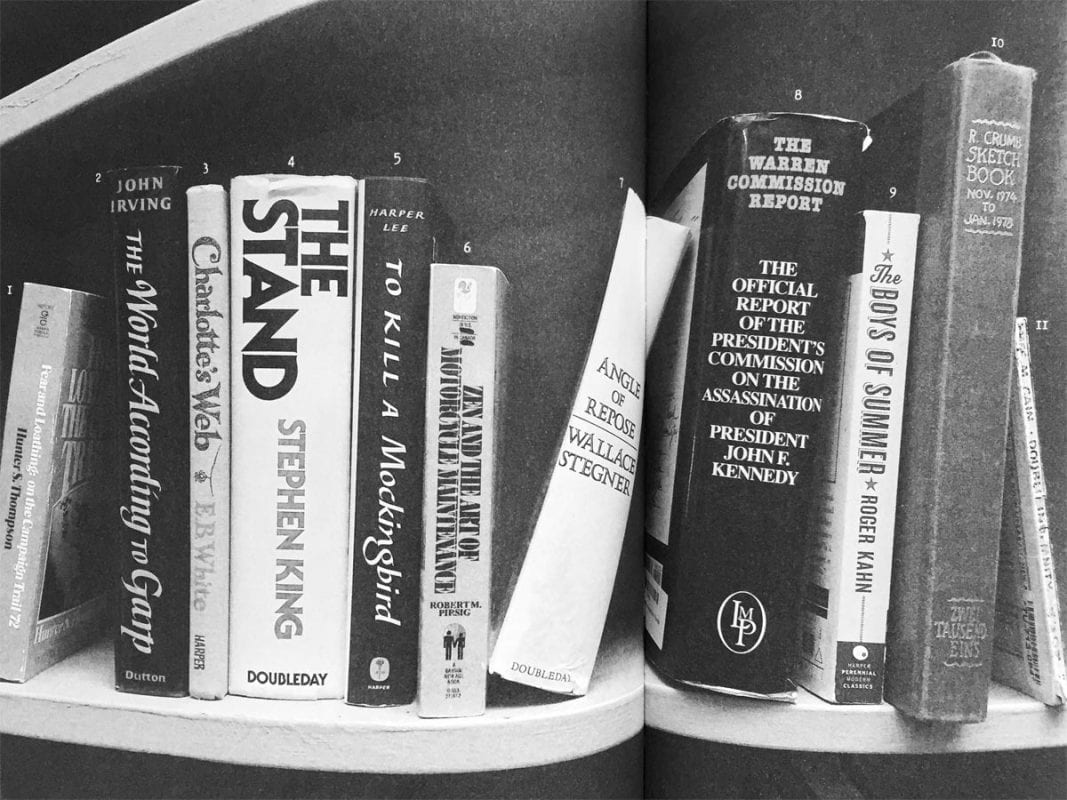‘Navigating Between Worlds: Understanding Twin Peaks Season 3’ is now available on Audio, read by author John Bernardy, exclusively for our Patreon supporters. For just $3 a month you will have access to our full library of Audio content, plus three new uploads every week. To sign up visit our Patreon page: https://www.patreon.com/25YL
If you feel like the central trauma of Twin Peaks (the murder of Laura Palmer) shouldn’t/can’t be undone, this Twin Peaks theory is for you. No matter how many Season 3 moments involve turning away from or covering over this fundamental trauma, reality cannot be expunged or explained away by persistent disinformation.
What’s my alternative explanation to the original Twin Peaks timeline being outright erased at the end of the Season 3 finale? Adam Stewart from the Diane Podcast was kind enough to read this before publication and summarized my thesis as such:
“A dream/nightmare born of trauma is encroaching on reality. To escape it, the characters, who are caught in a between place, need to make a choice: stagnate and enter the darkness, or join the world and step into the light.” He then suggested I saw Twin Peaks Season 3 as “a story about growth, change, and how to move beyond trauma, or not.”
I cannot say it more concisely than that, but I can elaborate: the between place he mentioned is Season 3 itself. It doesn’t belong to the Timeline or Lodgespace, but is made from both states. And all the characters trapped inside it are frozen in place or stuck in loops; in desperate need of restarting their energy.
If you need a visual metaphor to get started to see how Season 3 operates as an in-between state, imagine you’re in a movie theater. Season 1, Season 2, and Fire Walk With Me make up the screen itself. Lodgespace is the projector in the back, projecting a veil of images over the screen. Season 3 is in the seats with the audience as we constantly reinterpret what we see in front of us.
Continue on with this section of this Twin Peaks article to see the three most important scenes in Season 3 that define this layering reality. Otherwise, here is easy navigation if you’d like to skip ahead to the following sections:
- Three Season 3 scenes that explain reality and how to navigate it
- Defining the states of reality seen in Twin Peaks
- Ways we see the In-Between state of reality in Season 3
- How Lodgespace and Timeline are tethered to—and influence—the In-Between reality
- How Dale Cooper’s time looping defines the shape of the In-Between reality
- How trauma cycles trap characters in the In-Between reality
- How help—if chosen—assists characters as they approach the Timeline
- Case studies: How characters in Season 3 navigate the In-Between state
- How Dale Cooper navigates through the In-Between reality state
The three Season 3 moments that explain reality and how to navigate it
There are three sections of dialogue my Twin Peaks theory finds incredibly important for how I think reality within Season 3 is structured:
- Margaret’s phone call to Hawk in Part 10
- The conversation between an insurance salesman and Lucy in Part 1
- Part of an exchange between Frank Truman and Hawk in Part 11
In Part 10, Margaret Lanterman says this to Hawk just before Rebekah Del Rio sings “No Stars” in the Roadhouse
Hawk. Electricity is humming. You hear it in the mountains and rivers. You see it dance among the seas and stars and glowing around the moon, but in these days the glow is dying. What will be in the darkness that remains? The Truman brothers are both true men. They are your brothers. And the others, the good ones who have been with you. Now the circle is almost complete. Watch and listen to the dream of a time and space. It all comes out now, flowing like a river. That which is and is not. Hawk. Laura is the one.
Pamela Tarajcak of the Between Two Worlds Facebook group put it in a most easy to understand way: If Laura is the one, that could very easily be an answer to “that which is and is not.” Which means Laura is, and conversely Carrie is not.
This is a fantastic connection all by itself, but I’ll take Pamela’s idea and raise her realities: There is a reality that is (the one where Laura died) and a reality that is not (the one where Dale takes Laura from the Fire Walk With Me flashback and she becomes Carrie).
I know it sounds like I’m endorsing multiple timelines, but I am not. There’s a timeline where Laura Palmer died, and the other “timeline,” if you can call it that, is a dream. A dream, as Margaret says, made of a time and space.
Rather than a time and space dreaming this all up (which would encompass everything within Season 3), the “dream” is made of a time (likely beginning in 1989) and a space (spreading from Twin Peaks, Washington). This “dream” is what Dale works within after he accesses it in Part 17 from Jeffries’ slippery 8 made from an Owl Ring symbol—a symbol proven to be a direct connection into the Waiting Room. This “dream” that Margaret refers to is a reality made up of Lodgespace, just like Dale’s first dream in Episode 2 of Season 1 back in 1990.
Just because Margaret calls it a dream, though, doesn’t mean “it’s all a dream” as so many theories put it. If it was all a dream, there wouldn’t be so many random characters caught up in it. Plus, it wouldn’t be flowing like a river at Margaret and Hawk; they would already be in it. Margaret wouldn’t be worried about Lodgespace flowing over the Timeline, she would speak of a current instead, as if they were all part of the same watery state. She’s worried about Lodgespace convincing people that its dream is conveniently more real than a world where a girl was killed under traumatic, complicated circumstances.
What we have are two states of reality: the Timeline we instinctively understand, and Lodgespace with its dreamy non-linear behaviors. And as we see in my next choice of dialogue, it’s important to choose between them.
The dialogue between the Insurance Salesman and Lucy, one that brings up the Truman brothers again
Insurance Salesman: “I’d like to see Sheriff Truman.”
Lucy: “Which one?”
IS: “Sheriff Truman isn’t here?”
L: “Well, do you know which one? It could make a difference.”
IS: “Uh, no, ma’am.”
L: “One is sick, and the other is fishing.”
Why are the Truman brothers called out specifically? Because they are symbols of their states of reality.
Harry Truman represents the Timeline, where Laura Palmer 100% died like we know from the original two seasons of Twin Peaks. He is probably sick because Lodgespace is coming at him like a river.
Frank Truman is rooted in the front lines of Season 3, where aspects of Lodgespace are asserting themselves all over. How is that signified in Lucy’s simple dialogue? There’s an immediate commonality with Pete Martell, who’d “gone fishing” when he did not discover Laura Palmer’s body on the shore in the reality that “is not.” Pete Martell fishing is literally the first divergent event in the Lodgespace “dream” after Laura’s body glitches away from the shore.
Though Lodgespace is part of his in-between territory, Frank is not part of Lodgespace himself. He is a true man, after all. Margaret said so. But his presence is also a signpost for where the “dream” intrudes.
Then there’s this part of an interaction between Frank and Hawk as they looked at Hawk’s map in Part 11
Hawk: “[the symbol]’s a type of fire, more like modern day electricity.”
Frank: “Good?”
Hawk: “It depends. It depends on the intention, the intention behind the fire.”
Here is another reference to electricity. Coupled with Margaret’s “Electricity is humming. You hear it in the mountains and rivers. You see it dance among the seas and stars and glowing around the moon,” not only do we know electricity is everywhere, it appears electricity can be used for good (positive), while another intent could lead to darkness (negative). This implies there is a choice that needs to be made.
I contend the choice is between the Timeline with Laura Palmer (a positive intention), or the oncoming Lodgespace with Carrie (a negative intention). And according to Margaret’s words above, I think Harry and Frank Truman are some of the good guys who can use electricity in a positive way to push back the Lodge’s darkness.
I’m going to explain all of this extensively, but let’s begin by looking at the two main states of reality: the Timeline and Lodgespace.
Next: Defining the states of reality seen in Twin Peaks
Before I explain how I see a physical reality (Timeline) and an ethereal reality (Lodgespace) and the hybrid state of In-Between reality in the middle, I’d like to define my terms. I will be using many diagrams throughout this theory that include particular color coding:
Timeline side is blue
- it’s the Original Twin Peaks Timeline that’s of the world
- The World is coded blue in the song “Questions In A World of Blue”
- Also, Jacoby’s glasses, one side is blue
Lodgespace side is red
- The red curtains
- Fire imagery
- Jacoby’s other lens
The middle state is purple
- Jacoby’s lenses together provide a purple hue to the wearer
- The Fireman (provider of balance per my previous theories)’s realm is purple

Energy is green
- The green traffic light means traffic can flow rather than stand still
- The green sparkles on Dougie’s case files seems to coax CooperDougie into motion
Material and Non-Material States of Reality
Esoteric Buddhism model
Author Laird Scranton, in a recent interview on The Higherside Chats Podcast, explained how when researching near-forgotten spiritual teachings he uncovered an Esoteric Buddhist tradition of universes forming in pairs: one material (which matches with what I’m calling the Timeline) and one non-material (which matches with my definition of Lodgespace).
A form of energy cycles between these two universes like sand in an hourglass timer, from one to the other as if each universe was a die pole. When the energy makes it all the way to one pole, the polarity reverses and the energy begins to flow back to the other pole and the cycle begins anew.
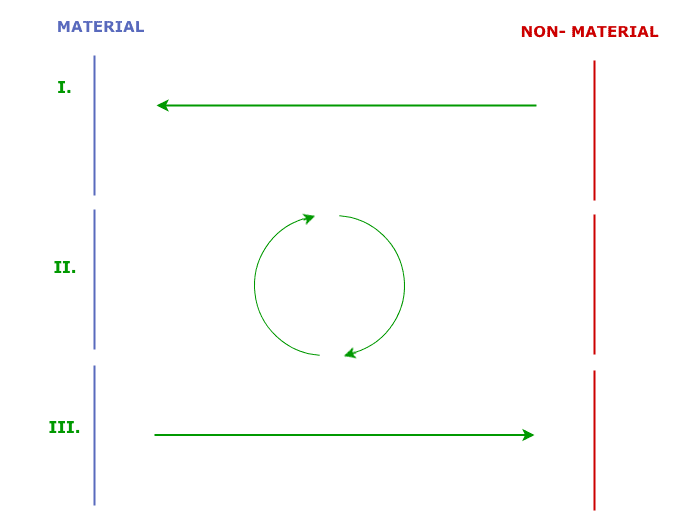 Scranton says the flowing energy is essential to life, and it cycles the same way as natural water cycle does on Earth. In Twin Peaks terms, this energy is signified by:
Scranton says the flowing energy is essential to life, and it cycles the same way as natural water cycle does on Earth. In Twin Peaks terms, this energy is signified by:
- Natural Electricity (everything from the impulses inside us, to what flows in ley lines)
- Fire (on Hawk’s living map)
- Alternating Current electricity (which Lynch has been fascinated by since at least Ronnie Rocket).
This energy hums, can be heard in the mountains and rivers, can be seen dancing among the seas and stars and glowing around the moon. It’s as natural as bodies of water and clouds in the sky, as humidity and rain. And it’s within every character in Season 3.
In addition to energy traveling between the universes, Scranton suggests that movement from the non-material to material is what ghosts may do, and in Twin Peaks theory terms is what the Fireman does. Though if you believe the Giant’s rephrased question of “Where have you gone?” the material also appears to find a way to travel to the non-material under certain circumstances as well. And there are portals (and mirrors, and windows) which allow access from one to the other. There is a framework within Twin Peaks that allows for travel between the two universes.
Many different aspects of the non-material universe have been described within the three seasons of Twin Peaks and the books (Secret History of Twin Peaks and Final Dossier in particular) in varying levels of esoteric and material. All of these aspects, whether gotten through direct communication with the non-material, or if its presence is merely felt, describe an aspect of Lodgespace much in the way the old adage works with blind men describing different disparate parts of an elephant. Any one of us can describe an aspect of the non-material and none of us can describe the entire thing. Our point of view from inside the material universe limits our ability to understand the other, yet we can describe aspects of a non-material universe.
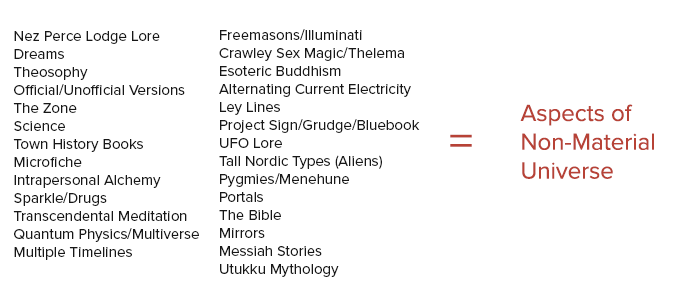 But why would the universes need communication?
But why would the universes need communication?
Scranton says when all the energy is almost completely in one universe, the other universe is at its weakest and needs the stronger universe to take care of it. Even though it can’t be seen or felt, the universe needs to be remembered or it could cease to exist. And both universes need to survive to maintain balance, otherwise the cycle goes u-shaped and dissipates.
Neither universe is higher or lower in importance. They are side by side. One cannot exist without the other. To this end, the universes need to train caretakers on the other side to prevent the twin universes’ demise.
Scranton says communication from the non-material to the material comes in these typical forms:
- Vivid images in dreams
- Synchronicities
- Unusual behavior of animals
- Divination
- Clairvoyancy and paranormal ways of knowing things
Tell me this doesn’t sound like regularly occurring events in Twin Peaks.
Esoteric Buddhism doesn’t have to explain everything exactly, but it sure matches well with everything about memory and the Fireman’s constant quest for balance that allows for evolution, as I described in How The Fireman “Brings Back Some Memories”. Two universes of different states needing to stay in balance with one another seems apt for what we see in Season 3 and the Frost books.
Why, if both universes are neither strictly positive nor negative by nature, does it sound like I was making a case for the Timeline being strictly positive and Lodgespace being strictly negative? Because Twin Peaks is from the perspective of human beings. In terms of human beings within the cycle of life, positive energy flow is through the timeline. The only time the flow reverses to Lodgespace is when a character dies. Because that’s a person’s natural cycle.
Why I most think Season 3 happens in an in-between state is because no scene is ever cut and dry as to whether it is in the Timeline or Lodgespace. Fans are constantly debating if the Roadhouse is material or non-material, if Audrey is in a mental institution or the Black Lodge. Fans debate if the Las Vegas scenes are any bit real, or if everything in Season 3 is a dream. And there is debate if Season 3 is connected to Seasons 1 and 2 or if it erases them outright, and whether or not the Fire Walk With Me ending is invalidated by the Season 3 ending.
There are good arguments for either side of any of these debates: because Season 3 is exactly in the middle of all the issues. There is equal evidence of material and non-material states because it is an in-between state of reality, a third state entirely. Which fits really well considering the Season 3 script is an exact middle point between David Lynch and Mark Frost.
The Script is the One
I believe the Season 3 script is a middle point between Mark Frost and David Lynch, best explained by this quote from Frost:
I would sit at the keyboard, and David would sit in a comfy chair, and we would go back and forth. You throw your minds up toward the ceiling, and they meet somewhere near the light fixtures. The script becomes written by a third party. The author is someone called Lynch-Frost.
Therefore:
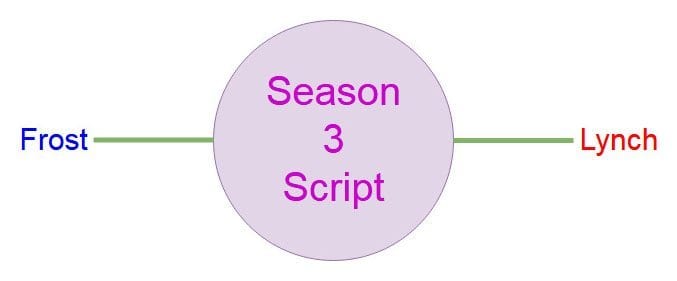 Neither Frost nor Lynch are positive or negative on this diagram, I merely put Frost on the Timeline side because of his expressed need to include the greater world (and its concerns and politics) into Season 3 while I put David Lynch on the side of Lodgespace because of his interest in Transcendental Meditation and hidden interior realms.
Neither Frost nor Lynch are positive or negative on this diagram, I merely put Frost on the Timeline side because of his expressed need to include the greater world (and its concerns and politics) into Season 3 while I put David Lynch on the side of Lodgespace because of his interest in Transcendental Meditation and hidden interior realms.
Also, there’s this:
 At the heart of this modern incarnation of Twin Peaks is both Lynch and Frost’s instinct to help people. Mark Frost delivers his interpretation of this message in The Secret History of Twin Peaks and The Final Dossier working within a framework of a Jungian collective unconscious neural network, with a social conscious focus on Light and Darkness, summarized well by this tweet:
At the heart of this modern incarnation of Twin Peaks is both Lynch and Frost’s instinct to help people. Mark Frost delivers his interpretation of this message in The Secret History of Twin Peaks and The Final Dossier working within a framework of a Jungian collective unconscious neural network, with a social conscious focus on Light and Darkness, summarized well by this tweet:
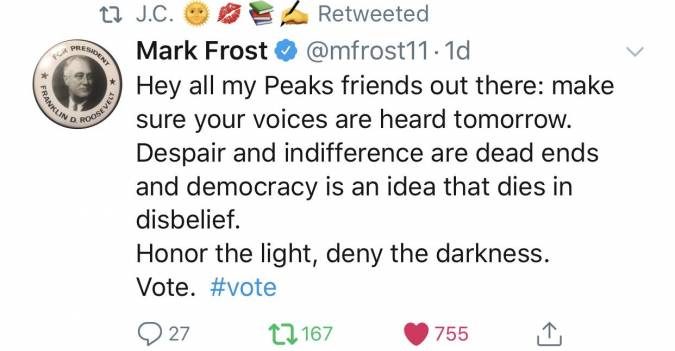 David Lynch delivers his interpretation within Season 3 by showing aspects of a meditation state dissolving the proverbial “suffocating clown suit of negativity” made from anger, depression and sorrow which he explains well in Catching the Big Fish.
David Lynch delivers his interpretation within Season 3 by showing aspects of a meditation state dissolving the proverbial “suffocating clown suit of negativity” made from anger, depression and sorrow which he explains well in Catching the Big Fish.
Both men show an instinct to help their fellow human beings. And their work here shows how they think humanity is best served during the time we’re given by striving for enlightenment/living in the present/embracing the light/using your energy in a positive way. Both men have different interpretations of how their message should be delivered, but at the base foundation behind the Season 3 Script is the message of this alchemic enlightenment and evolution.
 The path to get to this evolution is their own interpretation. Like themselves, neither interpretation is more positive or negative than the other. Like the material and non-material universes, Frost and Lynch’s interpretations are interconnected at a foundational level and unlock better understanding of the other.
The path to get to this evolution is their own interpretation. Like themselves, neither interpretation is more positive or negative than the other. Like the material and non-material universes, Frost and Lynch’s interpretations are interconnected at a foundational level and unlock better understanding of the other.
T. Kyle King of Wrapped In Podcast has an interesting angle on this:
With respect to the past, Lynch has a strong sense of nostalgia, whereas Frost has a strong sense of history. Lynch relates to the past emotionally, while Frost reacts to the past intellectually. For Lynch, the greater sin with respect to the past is to get so lost in the romanticized past that it blinds us to the opportunities available in the present. To Frost, by contrast, the greater sin with respect to the past is to lose awareness of it to a degree that causes us to make impractical decisions that lead us down ill-considered roads as a result of our ignorance. The interplay of these countervailing forces of emotion/intellect, nostalgia/knowledge, and past/present is reflected in your theory, and is shot through The Return, and nowhere more so than in Part 8, particularly in the juxtaposition of Sarah Palmer in an iconic moment of Americana (a boy and a girl in a black and white scene from the ‘50s) with the BOB-frog-bug unleashed by the atomic bomb crawling into her mouth.
As a viewer, you may be more tuned to Lynch’s point of view, or you may be more tuned to Frost’s, but it is up to you to decide where on the spectrum you fall. Personally, I try to fall right in the middle, which is probably why this Twin Peaks theory is being told from a point in the middle of the material and non-material universes.
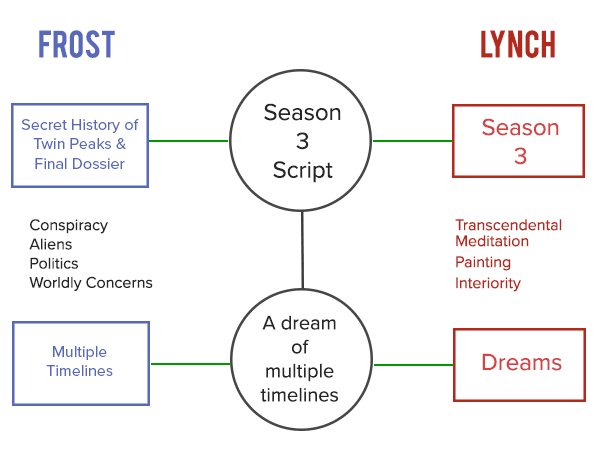 Next up: How the In-Between is shown in Season 3
Next up: How the In-Between is shown in Season 3
I’ve just explained why I conceptually believe in a state of reality that is stuck between the Timeline and Lodgespace. My Twin Peaks theory will now delve into examples that help to explain how this In-Between reality is represented in Season 3.
Characters in between
Frank Truman
When you see Frank, you know you’re seeing scenes set in the In-Between state of reality. I said earlier that Frank Truman signifies the intruding presence of Margaret’s “dream” while also still being attached to the Timeline. Because he only has one foot in the dream. His other foot is in the Timeline.
- In Parts 1 through 3, Frank is not present. I believe these Parts are mostly in tune with the Timeline. Frank also is not present in the second half of Part 17 or any of Part 18. I consider those to be mostly in tune with Lodgespace. Frank Truman only exists between those points in the undecided middle state.
- He neutrally reacts to both Wally Brando (full of positive energy and love for his parents) and Doris Truman (full of negative energy and trauma over their son’s suicide).
- Per Final Dossier, is the acting Sheriff for a set period of two years between Harry’s stepping down and Hawk’s taking of the mantle.
- Does not actively shoot DoppelCooper (though his hat takes a cartoonish hit from the bullet in a dreamlike way).
- Acknowledges in Part 7 that Laura Palmer was killed as he goes through the discovered diary pages with Hawk.
- Works in both the modern section of the sheriff station (where Maggie’s 911 dispatch station is located) and the older one where Andy, Lucy and Hawk go through files and discuss eating evidence.
- He constantly references fish, symbolically referencing Pete Martell fishing because Laura is missing.
- In Part 1 Lucy says he’s fishing.
- In Part 7, he and Will Hayward make fishing jokes over Skype.
- In Part 15, in a dark conference room, he was looking at pictures of fish when Hawk came in to announce that the Log Lady had died.
While the fish references are also signposts of Lodgespace’s “dream” asserting itself into this middle state of reality, I’m going to stick to the state of in-between for a while.
Other Characters
Hawk is between being a deputy and a sheriff.
The Log Lady is at the precipice between life and death.
Andy and Lucy are also stuck in-between in their way. As I explained in detail here, Lucy and Andy were released by Wally Brando from the past when he gave them permission to turn his kept childhood bedroom into a study more suited to their modern needs. Their arc within Season 3 transitions from the past to the present, but is mostly between these states until Lucy understands cell phones.
Gordon Cole, Albert Rosenfield and Tamara “Tammy” Preston patrol the cases that have equal roots in both the material Timeline and non-material Lodgespace.
Bobby Briggs patrols the border between Twin Peaks and Canada.
Every character in this show is on some sort of precipice, which I will return to at a later time, but as for now I think you get the idea.
Locations in between
All of the hotels and motels are places where people go when they need a place to stay when they’re between times of being at home. This includes the Great Northern with the hum in its boiler room.
The Double R and Roadhouses are places where you go to eat and live between the time when you’re at home.
The Dutchman’s is in a literal state between being material and non-material.
The Palmer House is material but its residents appear to be both from the material and non-material.
Stairways (and also ladders, if you include the case files illustrations that make Bushnell Mullins connect LVPD and Lucky 7 people together in corruption) are an actual location themselves, and it appears that the stairway in the Dutchman’s takes you from the material (ground floor) to the non-material (2nd floor). Not to mention Sarah’s room in New Mexico (per Final Dossier) and Laura’s room in Twin Peaks are on the second floor, connected by stairs.
That purple Zone with Naido and American Girl (themselves possibly in-between states of Laura and Diane while their tulpas exist nearest the time stream, or under some form of Lodge-style witness protection) was between Dale’s time in the Lodge and his time in Vegas.
The Farm, where the arm wrestling occurred, was described by Ray Monroe as something like a halfway house for released prisoners reintegrating into civilian society.
The Frost-described three-year-old ghost towns of Las Vegas are where Cooper entered the world between his time in the non-material and his time in the Jones home as Dougie. The houses themselves are in between being built and having residents.
Trailers like Fat Trout Trailer Park as well as Dr. Jacoby’s trailer on White Tail Mountain are neither moving vehicles or houses, but can be used as either.
The Roadhouse, where we see character behaviors and audio/visual cues associated with worldly scenes and Lodgespace scenes.
Junction Points
All of these in-between locations operate as junction points. Just like the Season 3 Script is a junction point between Lynch and Frost’s interpretations. Just like the Waiting Room and Fireman’s lair are junction points.
David Lynch regularly goes out of his way to say in various way he’s never shown the Lodges on film. In this Rolling Stone interview, Kory Grow asks Lynch what feeling he gets when on the set of the Black Lodge, and Lynch responded with this:
I call it the “Red Room.” And the Red Room is sort of a junction point. It can be a very good feeling and it can be not so good.
Frost, in The Final Dossier, alludes to the Fireman’s lair being a junction point when he says Cooper’s Double is looking for the coordinates so he could locate a grand central station of junction points. You can see this in action in Part 17 when the Fireman captures DoppelCooper, swipes away the image of the Part 12 Palmer House, bringing up the sheriff station instead and then that is where we next see DoppelCooper appear.
You can also say the entirety of Season 3 is a junction point for each character as they choose between positive and negative energy, which I’ve alluded to already and will explore in depth later. Right now, I will say that Season 3 operates as a portal for them, where they can go out into the positive or negative, depending which way they want to walk through the portal (or, if you prefer, threshold). Depending on which way you walk on the stairs declares which floor you end up on. And depending on which way you look into a mirror declares what you see as a reflection on the other side.
What I mean to say is Lynch loves his imagery to explain interior states. We’ve seen it in the original series especially with mirrors: Josie’s face is shown in the mirror first thing, her secrets and darkness reflected to us without us knowing what we’re seeing. Later, we see BOB looking back at both Leland Palmer and Dale Cooper. Used to be, you could see right through to the non-material through a mirror like it were a portal. Now in the stories sprung from the Season 3 Script, it’s as if we’re on the mirror itself, and depending which way your energy is tuned proves which state of reality you look out onto. The mirror is the junction point between image and reflection. And depending which way the mirror looks, you will see the image, or you will see the reflection. One is the Official Version, the other is the Unofficial Version, and the mirror is a portal to both.
We are on the mirror itself
I choose a mirror as the most apt comparison/metaphor for Season 3’s shape because of its historical use (BOB able to be seen in mirrors), as well as all the blatant reversals in modern Twin Peaks material from the original Twin Peaks material. When you put together images within Season 3 along with the number of blatantly reversed events within The Secret History of Twin Peaks and The Final Dossier, you’ll see what I mean when I write “look one way and you’re seeing the Timeline, and look the other way and you’ll see Lodgespace.”
In Frost’s Twin Peaks novels we get these exact reversals
In Season 2 we learn Norma cheats on Ed with Hank, and that sends Ed to marry Nadine almost right away. In SHoTP, we learn that Ed went to Vietnam and it was Hank actively intercepting Ed’s letters that caused Hank and Norma to marry first, with Ed marrying Nadine at a later point.
In Season 1 we learn Bobby is cheating on Laura with Shelly Johnson. In Final Dossier we learn Bobby is cheating on Shelly with Laura.
In Season 2, Ben Horne leaves his Civil War delusion by winning the war for the South. In SHoTP Jacoby guides him to let the North win the war to leave his delusion.
In Episode 29, Ben Horne hits his head on the Haywards’ fireplace before the bank explosion. In Final Dossier, the bank explosion happens before Ben’s injury.
Considered opposites in popular culture, Pete Martell plays chess in the Timeline and checkers in the in-between of SHoTP.
In the Access Guide to Twin Peaks, we learn that the Martells arrive first to Twin Peaks, followed by The Packards. In SHoTP, the Packards arrive first followed by the Martells.
Also in the Access Guide, the Twin Peaks High football team (Steeplejacks) has a perfect season thanks to a final play featuring Hawk. In SHoTP the team (Lumberjacks) suffered a defeat in the championship game thanks to Hank Jennings throwing the game on purpose on the final play.
In both of Frost’s books Margaret Lanterman’s last name is changed to Coulson. It is a tribute to Catherine Coulson, but it is also a reflection from the Log Lady’s role in the original series to her altered form in the in-between state (As we only hear Margaret contacting Hawk over a phone, I contest the Margaret Lanterman from Season 3 is calling in to the in-between from the Timeline).
And let’s not forget about the Bookhouse library page in SHoTP. Aaron Mento described how only the I, 8 and II were the same exact image with its original or when reflected in the mirror, and the first words of those books said “Fear the Double.” If this isn’t literally making the case for what I’m trying to explain here, nothing is.
In Season 3 we get these exact reversals:
In Fire Walk With Me, we get Phillip Jeffries saying “Who do you think this is there?” It’s more immediate, feels more like he’d refer to a person that way. In Season 3, there’s alternate footage of the same scene, with the altered dialogue of “Who do you think that is there?” Seems more removed to say that, removing a little humanity as well, as I would think “that” would refer more to a thing than a person. Also, “this” implies something right next to me or even in my hand. “That” implies a bit of a distance. It’s a tonal feeling but it’s there. Either way though, it’s not a precise reproduction, and therefore seems more akin to a reflection rather than an original image.
In Part 13, Ed is eating soup in the final credits, seeming terribly depressed and/or lonely. This is a sure sign that he’s tuning more towards Lodgespace at the time, and the part of him reflected in the window glass that’s slightly out of sync with him is tuned more toward the middle state. (Or it’s his more Lodgespace-tuned reflection and he’s in the middle state. Either way, neither seen parts are closest to the Timeline.)
In Part 2, Shelly says “James has always been cool.”
I also think things like backwards blinking are signs in Season 3 of seeing through to either Timeline or Lodgespace. I’m thinking specifically of Sonny Jim in the backseat, with Cooper nested inside Dougie Jones shedding a tear as to what he could’ve had if he was part of the Timeline. Therefore Sonny Jim, blinking backwards, is at that moment tuned to the Timeline.
Backwards speech and even the 119 Mom are all reversal Lodgespace signs being observed from the In-between.
Gordon Cole, likely while tuned to an Unofficial Version (Lodgespace), regularly says “apologies in advance for Albert” immediately after Albert says something offensive.
The way a Woodsman kills Bill Hastings is remembered backwards by Diane as she and the agents and officers recount events they can only remember after they’ve begun drinking coffee. She says, about a described Woodsman, “I think I saw somebody like that getting out of the police car,” but earlier Diane is only clearly shown watching a Woodsman go IN to the police car.
“Find Laura” can and probably does mean a number of things, but the root issue of Season 3 is choosing between that which is and is not. And I’ve already said Laura’s Timestream “is” and Carrie’s Lodgespace “is not.” As Leland went into the Light in Episode 16 of the Timeline-tied Season 2, Leland is probably making an appearance from another state much, as the Fireman appears in the Waiting Room in Episode 29. Leland is possibly warning Dale to tune to the Timeline rather than the Lodgespace that is throwing everything out of balance.
- The first time Leland is in the Waiting Room telling this to Dale Cooper, Dale is in an in-between state and he’s mostly tuned towards the Timeline, therefore he comes from one side of the screen.
- The second time Leland is in the Waiting Room, Dale is coming from a time when he’s already “saved” Laura from her death and is therefore tuned to the Lodgespace “dream” where Laura did not die (Phillip Gerard saying the “Fire Walk With Me” poem in normal speech rather than backwards-speak could also be evidence that Dale has been tuned closer to Lodgespace). He comes from the opposite side of the screen in an exact reversal of the film from the previous scene. And later Dale finds Carrie.
Moments that stutter (primarily the Part 8 stuttering Woodsmen scenes, the Part 17 clock in the sheriff station, and Frank and the Deputies superimposing in Part 14) seem to be oscillating quickly between Timeline tuning and Lodgespace tuning due to their proximity to portals. The closer you are to a portal, the closer you are to a doorway between those two dimensions and I suspect you’ll be able to see all your options most clearly then; as if all your frequencies are present at once like an orchestra rather than a solo instrument.
But remember, if you can see these other reality states, they can see you too.
Next: how we see the Timeline and Lodgespace influencing the In-Between state of reality
No scene in Twin Peaks Season 3 is ever cut and dry whether it is set in material reality or Lodgespace. This Twin Peaks theory will explain how both the Timeline and Lodgespace could be simultaneously tethering onto this in-between state of reality, fortifying both its shape and its solidity.
How Lodgespace asserts itself into the In-Between reality
Besides the reversed polarity of Dale and his Doppelganger, there are a number of ways Lodgespace and the Timeline adhere to this in-between state to make it a more solid construction. Here are some of them.
Glitches
DoppelCooper, made of pure Lodgespace, has his agents on Earth. Some of them are killed on screen, and there are glitches at the moment of their deaths: Phyllis Hastings, Warden Murphy, Duncan Todd and Roger. The direct connection/influence of DoppelCooper was disconnected from their bodies as their life force was no longer part of the energy cycle and only their bodies remained.
The same glitch happens to the doorknob of Gordon Cole’s room in Buckhorn as Tammy arrives there in Part 10. What happened right before it? A vision of Laura from Fire Walk With Me flowed through that doorway like a river. It was likely a temporary influence from Dale’s 1989 “dream” that disconnected as Albert arrived. Why did Cole receive that vision? He was free drawing, in tune more than most people with dreams, and therefore Lodgespace.
Fog
In addition to the glitch at Gordon Cole’s door, the vision also left in a fog. Per Tamara Preston’s report in The Final Dossier, she asks questions of people regarding the validity of Laura Palmer disappearing (rather than being murdered):
[T]hey all got a slightly dazed and confused expression on their faces when I brought it up, as if they were lost in a fog, having trouble recalling, unable to fully wrap their minds around something that happened so very long ago.
Until finally they said, each and every one of them, “Yeah, that sounds right. That’s how I remember it.”
Later on, Preston explains her own thoughts possibly re-tuning:
Chief, I’m glad I’ve written all this down rapidly, because my own thoughts about every one of these events are growing fuzzier and more indistinct the longer I stay here, creeping into my mind like a mist.
Sounds like tuning from the In-Between reality into Lodgespace, as far as I’m concerned.
The Unofficial Version
Jeffries is untethered enough from time to know that the Unofficial Version likely comes from Lodgespace, and that Gordon Cole is in the middle enough where he’s able to tune to Lodgespace at least as often as the Timeline. How do we see Gordon tuned to the Unofficial Version besides his odd reindeer drawing?
- He’s there at the end with Diane and Cooper: Dale Cooper wants him there at the end of the Timeline before he goes all-in with changing events.
- The Judy ret-con: Out of nowhere, blatantly disregarding both subtlety and continuity, Gordon explains a plan to find an entity of negative energy known as Jow-Day. And this happens near the end, after the frequency of Lodgespace (and Unofficial Version) seems to be well-asserted into the story despite Dale having yet to travel back in Lodgespace time to “save” Laura.
- When Tammy is inducted into the Blue Rose Task Force, there’s a room with red curtains and Diane says “Let’s Rock.” If they’re not privy to Lodgespace-adjacent tuning, there’s no way to explain that coincidence. Lynch uses his symbols as language, not inconsistently. I think, as that’s Part 12 right around when Sarah Palmer starts to break down in the grocery store, this scene is a sign of Lodgespace asserting itself.
- Albert, Albert, Albert: In a scene made entirely of blue tones (my code color for Timeline), Gordon Cole deliberately and slowly says “Albert” three times while a strange hum fills the air, as if tuning from the Timeline into a completely different frequency. While the color doesn’t change, it appears they reach a different state (the In-Between state, from the Timeline) as they decide the tulpa version of Diane is part of their shared experience.
- “I’m really worried about you”: another Albert connection. Albert seems connected to the Timeline most. Gordon re-tunes him in that just-mentioned blue-hued scene by saying his name repeatedly and slowly over the strange hum. Albert has a happy dinner date with Constance Talbot. And he doesn’t seem to catch onto any clues from Gordon’s Lil-like French Woman. He regularly needs help from Gordon tuning to the middle. When Gordon says “I’m really worried about you,” Gordon may know that his agent, tuned mostly to the Timeline, is only in the middle zone because (like Margaret Coulson, Will Hayward and Harry Truman) he’s near to death. And with that logic, it’s quite possible that the fog cleared from the Part 10 Laura Vision because Albert was closer to the Timeline and pushed the dream away.
Visual recognition/ object permanence
It seems that any number of non-material things from Lodgespace need to be visually recognized in order to become fixed in reality. This probably goes back to faerie magic, where you can get faerie and leprechaun magic to work for you, but you have to keep an eye on them the whole time or they disappear along with their magic. If you look away from them for even a moment, as Rosie says on The Shadow Trap podcast, “they turn into a rock.” So too do Lodgespace things fade away, as if they were just a dream all along, if not properly acknowledged by the material universe.
- DoppelCooper: The doppelganger himself possibly needed to be captured on film for his solidity: First with a man near the glass box, and another time in one of his palaces in South America.
- The Owl Ring: It was able to be used as a key near portals when covered, but it became real and a portal all its own when per Secret History of Twin Peaks it was removed from its pouch after Merriweather Lewis was killed and it was stolen from him.
- The Glass Box: Sam needed to be there the whole time to visually verify things that come through it.
- Sam was not there for Dale Cooper’s pass-through. Dale continued on.
- Sam (with Tracey) was there for Experiment Model. It broke through and ate him as real as any earthly predator.
- Coordinates: Ray Monroe says in Part 15 that Jeffries told him not to write down the coordinates. Per Final Dossier, “Hastings indicated that [Briggs] had cautioned them to put nothing on paper.” In Part 15, DoppelCooper takes out a pad of paper and a pen to write down every single coordinate Phillip Jeffries reveals in his smoke.
- Dougie’s Wedding Band: I explored many avenues of why Major Briggs had Dougie’s wedding band in his stomach, but it could be as simple as this: Dougie Jones needed to be anchored to the Timeline by those who knew Dale Cooper. This could be what was needed to anchor Dale to the In-Between reality even though he completely believed that he could not be on Earth until his doppelganger switched places with him. “Did they ask about Vegas yet” could be DoppelCooper asking if they’ve anchored Dale to the In-Between reality yet and therefore DoppelCooper knows he still has time before he has to meet Dale.
- Diane: In Part 18, during the most awkward sex scene of all time, Diane covers “Dale’s” eyes, as if to unanchor herself from the Lodgespace-adjacent frequency. (which, among other things, I explain in-depth in Why Diane and Laura are the Heroes of Twin Peaks).
IT IS IN OUR HOUSE NOW
In a variation of visual recognition, it’s possible “It is in our house now” could mean that the “dream” (Lodgespace frequency) was asserting dominance over the In-Between reality and the Fireman was giving Dale clues so that he could break out of his Lodge loops and undo the Lodgespace frequency before Lodgespace fully asserted itself over the Timeline. In order to not anchor it even further, the Fireman could not give it a proper name or refer to it as anything, because that would attach it even more than it already dangerously was.
The glitch as Dale disappears at the end of that scene, by the way, is different than any other glitch besides the one where Laura Palmer’s body is overwritten from that of the timeline. What I see this glitch as, is this: the POV is likely from within a Lodgespace territory, and the glitch connotes something leaving Lodgespace for frequencies closer to the Timeline.
T. Kyle King also asks:
Could this also explain why the Fireman shows scenes to Andy (in what also appears to be a crucial scene affecting this theory) on a porthole above Andy’s head? In Part 8 and in Part 17, we see the Fireman watching events on a large screen directly before him, in his clear line of sight, but what he shows Andy, he shows in a place and in a way that only Andy can see, so the Fireman cannot even accidentally gaze upon what Andy is being shown. (Could this relate to DoppelCooper being anchored by images of himself?)
I like the way Kyle thinks. Maybe the Fireman can’t look at it because of DoppelCooper’s presence (or the presence of other frequencies in any capacity) in that vision. There’s plausibility for this, with references of multiples (the #6 pole for example) that could be visual confirmation of up to three different realities in play.
This sort of thinking can also apply to Hawk telling Frank “you don’t ever want to know about that” when asked what the black winged dot symbol means, and really, about why no one ever wants to talk about Judy. The fact you have to name Ultimate Negative Energy something else entirely implies just saying it out loud can attach it to the speaker’s worldview.
This can apply to the Monica Bellucci Dream, too. Once Gordon speaks of it, suddenly Albert can remember it as well. I don’t have all the subtleties down, but there’s definitely something to this line of thought.
How the Timeline re-asserts itself into the In-Between reality
Twin Peaks Music from Seasons 1 & 2 and Fire Walk With Me
We hear “Dark Mood Woods” when Hawk is going to the red curtains in Part 2 as he’s still tuned completely to the Timeline. We hear “Laura Palmer’s Theme” as Andy has his failed meeting with the Farmer in Part 7.
These are when the Timeline is being overwritten by the In-Between reality, but then in Part 4 there’s when Bobby sees Laura’s homecoming photo and begins crying while “Laura Palmer’s Theme” plays. I’ve previously credited this moment as the truth being remembered in How The Fireman “Brings Back Some Memories”, and here, the truth being remembered is tuning to the frequency of the Timeline rather than the In-Between.
Audrey almost breaks out of her Lodge-adjacent state as “Audrey’s Dance” (which is verbally named in-show) plays, but then she relapses back into Lodge-adjacency and the song plays backwards over credits in a blatant reversal or take-back.
And let’s not forget James singing at the Roadhouse just to remind us how things used to be.
Through a lifting fog, “Twin Peaks Theme” plays every week along with Laura’s photo image, but then we enter the Lodge by the end of the opening credits as the music fades away.
The most Timeline-asserting moment happens with the Part 16 reemergence of Dale Cooper after weeks of only Dougie Jones. The take-charge charmer we all know is awake and we hear the longest version of “Twin Peaks Theme” we’ve heard in a while. He takes it back later just like Audrey does, but we almost had a breakthrough there.
Phone calls
Will Hayward, Harry Truman and Margaret Coulson all call characters during the course of the show. They are between life and death (an in-between state all by itself) so that’s perhaps how they entered the in-between state, but the phone lines are part of that equation as well.
There’s also the curious case that Ray Monroe only spoke to Phillip Jeffries over the phone, traversing frequencies and probably from the In-Between reality to either Lodgespace frequency or Lodgespace itself.
Another phone call that may go from one state to another is Bushnell Mullins to Gordon Cole in Part 16. As Dale is tuned closely to the Timeline at that moment, and Gordon Cole was tuned mostly to the Judy ret-con (Unofficial Version) it’s quite possible they needed the phone to communicate just as much as DoppelCooper needed the phone to return him to the in-between state of reality from the Lodgespace location of the Dutchman’s when he met with Phillip Jeffries in Part 15.
I’d also posit a guess the ringing phone in Carrie’s Odessa house was there to bring Dale or Carrie from the Lodgespace frequency back to the middle frequency of the In-Between reality, though I freely admit this one is pure speculation.
And then there’s the curiosity of DoppelCooper’s cellphone usage. Why does he collect so many phones? Could it be that he needs them to access Lodge logic, which looks to the material world like magic? Does each phone serve as a short range re-tuner so that Lodgespace influences his reality the way he wants it to? That’s my hypothesis.
Pie and Coffee
Margaret invites Hawk over for pie and coffee but he chooses to stay in the in-between state.
Coffee is present during leaps of intuition or revelation per usual, though coffee (perhaps just like the Timeline itself) is nowhere near as present as it used to be.
Cooper-as-Dougie brings a pie to the Mitchums and it changes their tune from dark thugs to generous hearts of gold.
Over the phone, Shelly invites Becky to the Double R for pie, and Becky accepts.
The Great Northern Key
It comes from the pocket of Dougie Jones from Lodgespace, but it seems the key is a remnant of the Timeline and is possibly a symbol of Dale disconnecting from the Timeline, only to reconnect to it at the end when he begins his reconnection with his shadow known as DoppelCooper.
Jade gets the key first and sends it through the mail after helping Cooper-as-Dougie then presumably leaving for the Timeline. Then it goes through the mail, and to Ben Horne, who “remembers” events associated with it. And when Ben hands the key to Frank Truman, he says “for Harry.” Which is another nod to remember the Timeline.
Soil
The note within Major Briggs’ message pod asks Frank and the deputies to put soil in their pockets. I assume it’s so they can tune to the correct state (their current In-Between frequency) when the vortex closes. The soil grounds them in the particular reality state much like Albert grabbing Gordon’s shoulder anchored Cole at the Buckhorn vortex site.
Signposts for which frequency we’re experiencing
People
For the Timeline, we have the mention of Harry Truman and Margaret Lanterman/Coulson. We also have the Homecoming Photo, which I explained at length in How The Fireman “Brings Back Some Memories” and a trigger to remember Laura and the fact that she died.
For In-Between reality, we have Frank Truman.
For the Lodgespace frequency, we have the mention of Billy—which I will go into later on.
Lucy’s Timepieces
Kylee Karre of the Between Two Worlds Facebook group noticed Lucy wore a single timepiece as a necklace up through Part 7, and that afterwards she wore two timepieces as necklaces, up through Part 17. Kylee thought the findings of her excellent work were a solid marker for keeping track of timelines, but it works just as well for keeping track of which frequency the show is currently tuned to.
What does this mean to me? When Lucy’s stuck in the past, she is frozen in place and tuned to the Timeline frequency because it is associated with the past she remembers. When the Lodgespace frequency begins to assert itself over the In-Between reality, her two timepieces show she’s stuck in the middle. In Part 17 when she literally shoots the source of actual Lodge-based darkness (DoppelCooper), she is wearing a single timepiece again, signifying she’s tuned back to the Timeline frequency, but this time because she actually chose that frequency rather than being frozen there.
How does this show something besides her internal changes? From that point forward in Part 17, Lodgespace and the Timeline begin to separate once more. It’s possible to see this as the Lodgespace “dream” winning, but it wasn’t Dale who ended his doppelganger’s time, it was Lucy and the representatives of the Timeline (like Freddie) who did it while Dale stood there. They pushed back against the darkness, forcibly and literally.
This is why I think Lodgespace frequency appears so different from the others. It’s been pushed out on its own. And because the camera POV is following Cooper, we don’t see much more of the Timeline then. But as I’ve said before, the Timeline is still there all the same.
Memory
Everything I ever said in Fireman Brings Back Some Memories about the golden orb and the Laura Homecoming picture triggering memories of the truth is still accurate within this theory. Making someone remember the truth that Laura died felt emotionally true and explains the what that happens, and I feel this exploration of tuning between the coexisting Lodge-adjacent frequencies and the Timeline can actually explain the how of it.
Remembering Laura’s presence (that is “missing” from their perception) re-tunes characters from the In-Between reality to the Timeline. The presence of the symbol of Laura’s death (that’s what that picture means to all of us who ever watched the show years ago) makes people “find Laura”.
Though, like all the other stuttering time, I believe there are oscillations in play. There is tuning back and forth in Season 3 between events closer to the Timeline and those more tuned to Lodgespace. Just like Dale coming back in his most close-to-Timeline way in Part 16 right before he dives headlong into Lodgespace’s dream logic.
Just like a clock that moves back and forth between 2:52 and 2:53. Just like that arm wrestling scene goes back to starting positions.
Every character’s struggle in Season 3 is an oscillation between these frequencies, and every instance of remembering means you’re tuning from a point of view directed to Timeline to or from Lodgespace. As you re-tune, you “remember” things in this new loop you’re freshly experiencing, much like how the Part 8 “flashback” is being introduced (or “remembered”) right after whatever the Woodsmen did to DoppelCooper and the musical rite incited by the Nine Inch Nails.
But why is this happening?
How do all these characters and locations exist in this in-between state? As Dale Cooper created the Lodgespace “dream” that is flowing at the Timeline like a river, I believe he is also the cause of the In-Between state of reality in the first place.
Next up: How Dale Cooper formed the shape of this In-Between state of reality
Dale Cooper is the reason for the shape of the In-Between reality
Season 3 is oftentimes described as Dale’s internal process of finding himself, reassembling himself in a Jungian way that I believe Frost intends. But how does that explain all the other characters caught up in Season 3? This Twin Peaks theory supposes Dale Cooper tied the Timeline–and everyone in said Timeline—and Lodgespace together when he entered the Waiting Room in Episode 29 and switched places with his doppelganger.
DoppelCooper is made of pure non-material and Dale is made of pure material, so there is now a tether to the Timeline within Lodgespace and there is a tether to Lodgespace firmly embedded in the Timeline. They shoelaced both states of reality together with their ties to their home states.
The polarities of Dale Cooper have flipped, and Dale (as he exhibits in Parts 17 and 18) is acting like he’s as powerful as (and probably has become) a magician. Therefore, much as Lynch’s dreamer concept, Dale’s formed a state of lucid dream, where, as Mike Wilson from the Drink Full and Descend Podcast defined it, things appear to be exactly half in the waking world and half in the dream. Because Dale is the one who’s reversed polarities, this pulled-together reality is shaped to his order.

Or:
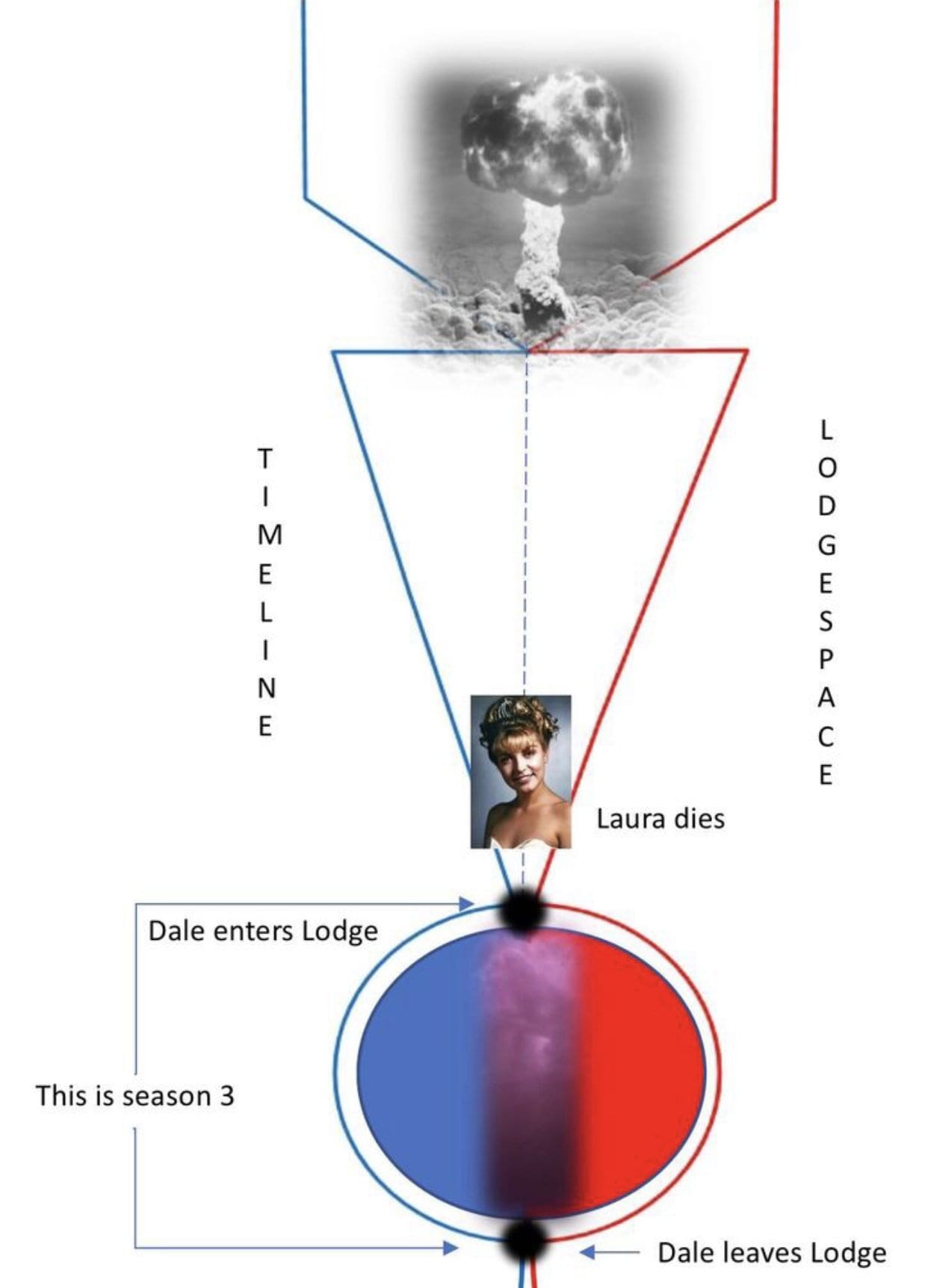 As a human being from the Timeline, Dale experiences his life in chronological order.
As a human being from the Timeline, Dale experiences his life in chronological order.
As he experiences it through time loops within the lodge, his experience also happens as if they were multiple times over the exact same period of time within the time stream. The evidence of “multiple timelines” comes from this. The evidence of what I’ve been calling Timequake since Secret History comes from this as well, except instead of two tectonic plates interacting and causing vibrational shockwaves through time, it appears that Dale Cooper is the specific nexus point of interaction and all the shockwaves go through and from him. Before I rationalize these “multiple timelines” happening concurrently with the real timeline, I will go through Dale’s time loops in chronological order from his point of view, as if it were all a straight line. Because this is how Dale experiences it.
Dale Cooper in chronological order
 As told in a line, we can see how Dale, as a person dealing with trauma, is in a point between understanding and a decision. Another in-between state.
As told in a line, we can see how Dale, as a person dealing with trauma, is in a point between understanding and a decision. Another in-between state.
I’ll include it in two rows here for visibility purposes:
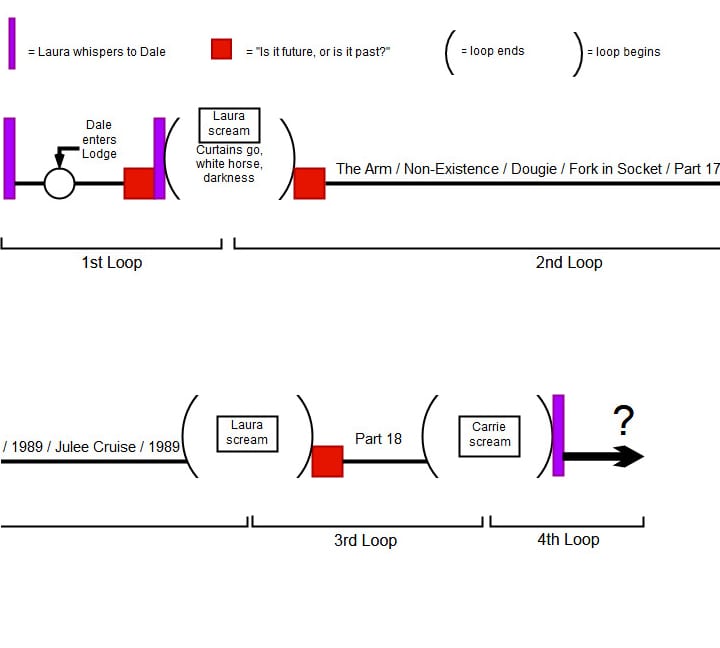 In Why Diane and Laura are the Heroes of Twin Peaks – Electricity Nexus #21 I explained a particular choice Dale makes near the beginning of Season 3:
In Why Diane and Laura are the Heroes of Twin Peaks – Electricity Nexus #21 I explained a particular choice Dale makes near the beginning of Season 3:
Laura, in Part 1, literally says “You can go out now” but he chooses to wait around for an excuse why he couldn’t. It’s that BOB problem. He’s got to defeat BOB first and get the doppelganger back in. THEN he can leave. It reminds me of how Audrey couldn’t possibly go to the all-important Roadhouse even though her husband said he’d go with her, and she stops going just because he was sleepy. If Dale REALLY wanted to leave the Lodge, he could’ve gone when Laura said he could leave. Instead he chose to believe Gerard and the BOB excuse, because that suited his wants better.
Dale does not go out when Laura/Carrie says he can “go out now,” because he is not ready. Instead he meanders his way into an in-between state as Dougie. I will explain later how Dale’s state of mind personifies his particular time loops, but first, let’s establish where they are.
During Dale’s Lodge stay, two events happen three times each, and they are out of sync with each other:
- “Is it future, or is it past?”
- Laura whispers to Dale.
These are where loop points happen.
I’ll get back to the Laura whispers as I think they point to a hopeful conclusion that is tuned more with the Timeline (as he first received the whisper while he was completely attached to the Timeline), but I think Dale had a choice to choose Love or Fear during Part 2. He could choose to believe Laura when she told him “you can go out now”, or he could follow the path as he tries to answer “Is it future or is it past.” How to put it more plainly? Dale has a choice: Leave the Lodge (as Laura suggests), or go further into the curtains (as Phillip motions him over that way). He chooses to go into the curtains; literally deeper into Lodgespace.
Here, I will break down the time loops into definitions so you know exactly what I’m referring to when I use loop numbers:
- 1st Loop: The Timeline-adjacent frequency. But the one that interrupts the natural Timeline events (such as Hawk not meeting Dale as the Lodge curtains in Part 2). This is also where DoppelCooper makes the glass box and amasses his criminal empire and wealth while Dale is in the Waiting Room.
- 2nd Loop: The In-Between reality. This begins with Dale leaving through Non-Existence, then living as Dougie Jones, and ends in all the superhero stuff at the sheriff station. This is the only loop that specifically mentions Judy, Freddie, an unofficial version, or any plan between Briggs, Cooper and Cole. It’s also the only loop that includes Sarah Palmer as a possessed woman, Experiment, Experiment Model, or the Fireman and Dido sending a Laura orb into the world through their junction point.
- 3rd Loop: The Lodgespace-adjacent frequency. This is a dark world where very few people are. As far as I’m concerned, this is the dream Margaret warns Hawk about, and this is the one where Laura Palmer is Carrie Page and Diane somehow becomes Linda as she likely detaches from the dream midway through. This is Dale’s hubris run amok as he ignores the fact of genuine history.
- There is a 4th Loop as well. It only just begins in the credits to Part 18. It could be a full reset because it begins with the whisper from Laura rather than “Is it future or is it past,” but we may never know because it begins in the ending moments and is currently unfinished. More on the 4th loop later.
Here is a visual representation of how I believe the four loops are stacked onto the timeline:
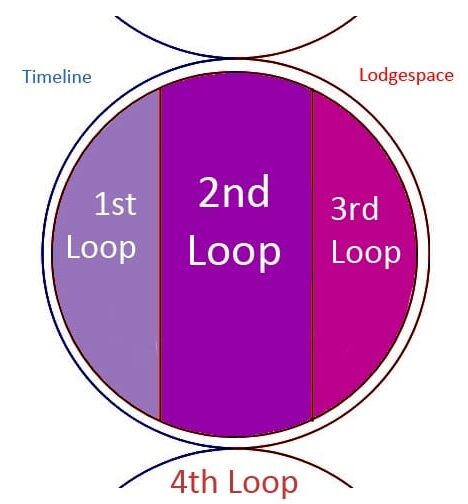
The 2nd loop is the one in the middle, the POV location of Season 3. If you look (with the intention of positive energy) to the Timeline, you’re tuned to see events close to how they went in the 1st Loop.
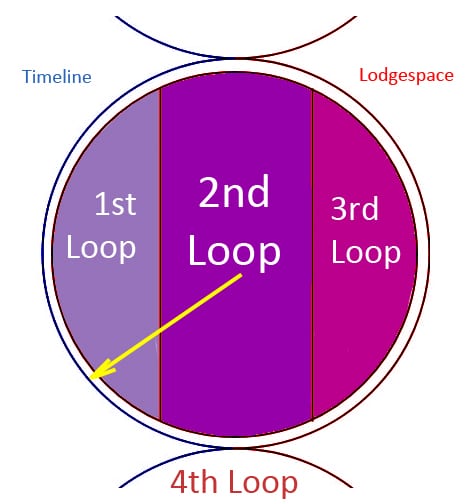
If you look (with the intention of negative energy) to Lodgespace, you’ve tuned to see events close to how they go in the 3rd Loop.
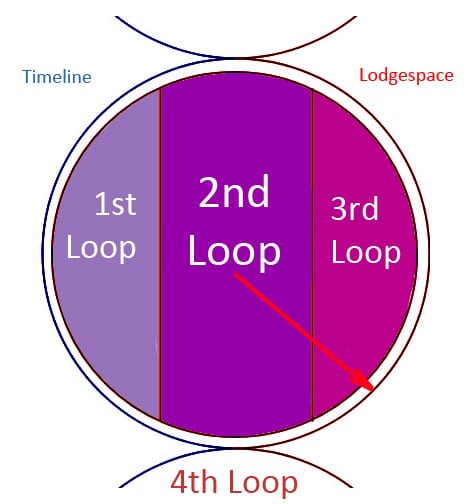
Because the loops happen in order for Dale, we feel the time loops assert themselves in that order within Season 3. That’s why people like Jerry Horne feel they’ve “been here before” too.
We see the original Timeline/1st Loop superseded by the 2nd Loop: instead of Hawk meeting Dale when he sees the red curtains in Part 2, Dale overwrites the perceived timeline by beginning the superhero arc that contains the Judy plan and Freddie vs. BOB. Hawk never once mentions the curtains scene because he’s tuned to the 2nd Loop now.
In Part 10, Margaret speaks to Hawk about the dream asserting itself too, which I say is visual confirmation of the 3rd Loop superseding the 2nd Loop. though that started in Part 7 with Andy not having a chance to meet the farmer at Sparkwood & 21 (hence the dramatic Laura Palmer Theme in the scene). Both loops flowed like a river over what came before, settling into its place as the dominant point of view that we see. Dominant because it is Cooper’s point of view.
The path we are shown in Season 3 tunes and re-tunes generally to this line:
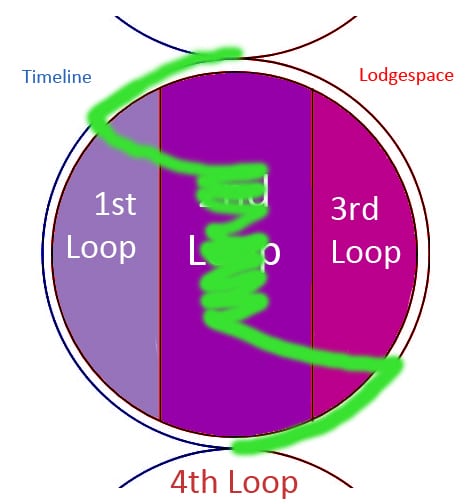 The rest of the circle is still there. Even when you’re hip-deep in this In-Between frequency, the trauma Dale wanted to erase hasn’t gone anywhere. And neither has the Timeline (or Laura’s death). Dale’s just looking away from it after Part 17, at least until that 4th Loop.
The rest of the circle is still there. Even when you’re hip-deep in this In-Between frequency, the trauma Dale wanted to erase hasn’t gone anywhere. And neither has the Timeline (or Laura’s death). Dale’s just looking away from it after Part 17, at least until that 4th Loop.
And that dangling 4th Loop at the end resonates with the missing diary pages Hawk and Frank read in Part 7. Three pages were found. Three Lodge Loops are shown in Season 3. Hawk and Margaret’s Log were “on the same page” right before the 1st Loop ended, Carrie Page is in the 3rd Loop, and there’s a missing 4th page we know about but cannot read just as there’s a 4th Loop we know about but will never experience as it only exists beyond Season 3.
Dale’s not the only one traveling these frequencies
Now that we’ve explored the shape of reality, and Dale’s state of mind when he’s traveling his Lodge loop frequencies, it’s time to move onto how other characters can fluctuate across these frequencies towards the Timeline or Lodgespace from within this In-Between reality, depending on the frequency of their own states of mind.
Next up: How characters can Fix their hearts (Rejoin the Timeline and step into the light) or Die (stagnate and enter Lodgespace’s darkness)
Twin Peaks Season 3 has taken a lot of flack for not feeling like there are protagonists, antagonists, or even things they want. At the time, I knew it had to be purposeful, but all the same I couldn’t quite understand it. But over time, I’ve come to this conclusion:
I think Season 3 is all about how characters come to make the decision to break through their trauma and send their energy in a positive direction (to the Timeline, where the truth is that Laura dies) or a negative direction (to Lodgespace, where Carrie unrecognizably lives).
The option for characters to choose between Timeline and Lodgespace is, as I’ve explained earlier in this Twin Peaks theory, best exemplified by this exchange between Lucy and the Insurance Salesman in Season 3 Part 1:
Insurance Salesman: “I’d like to see Sheriff Truman.”
Lucy: “Which one?”
IS: “Sheriff Truman isn’t here?”
L: “Well, do you know which one? It could make a difference.”
IS: “Uh, no, ma’am.”
L: “One is sick, and the other is fishing.”
What happens to the salesmen after these words? He panics and leaves before choosing to speak to either sheriff. He didn’t know which one to speak with so he spoke to neither.
His indecision is a microcosm of every character struggle in Season 3: the characters are frozen in place by trauma and/or stagnation, and their biggest struggle is to break through the barrier that strands them in their personal and external trauma. Trauma freezes you in place. So does being stuck in a rut. Your energy is not flowing. It’s stuck in the middle, not part of the flow that goes between and through the material and non-material states of reality, what I’m calling the Timeline and Lodgespace. Scream. Break the dam. Your energy will flow again. You are no longer stuck between states. You are traveling again.
And once your energy begins moving, you can choose how to direct your energy, as best expressed by this dialogue between Hawk and Frank in Part 11:
Hawk: “[the symbol]’s a type of fire, more like modern day electricity.”
Frank: “Good?”
Hawk: “It depends. It depends on the intention, the intention behind the fire.”
I still firmly believe what I wrote in The Central Question of Twin Peaks: When confronted with trauma, do you look away or shovel yourself out? where I suggested that every character in Season 3 processes their trauma and then immediately leaves the story. Now that I’ve dissected the reality structure as I have in this Twin Peaks theory, I can finally offer you a plausible reason as to how and why this happens. Most of it involves tuning from the in-between state to either the Timeline or Lodgespace, which to viewers usually looks like someone remembering something.
Breakthroughs are a major focus in Season 3. Every time someone screams, you know someone’s broken through their wall and are on their way to waking up. But it takes a lot to get to that moment. It takes a while. Remember how long it took Dale to wake up? Surely, Dougie drinking the coffee will wake up Cooper, right? Surely, sex with Janey-E will wake him up. That “damn good” pie with the Mitchums, right? Everything in Season 3 felt like the perfect trigger to get Dale Cooper back to us, but it wasn’t just one of those things. It was all of them, added together, adding weight until the veil was pushed back and Dale had no choice but to “wake up!”
We’re going to see the characters we remember this week, right? It took way longer into new Twin Peaks than we were expecting before we saw characters we were dying to see again (read: Audrey, Big Ed) and when they did arrive they were not announced with any major gravitas. They just showed up.
We’re going to have a breakthrough and energy will start moving in a positive direction now, right? It always takes longer than you think to heal, doesn’t it? And you never know you’re healed, you never know you actually processed your trauma, until you do. And you probably already did it before you realize you’ve done it.
I will show you here how the characters get to the point of jump-starting their energy, and how their breakthroughs allow themselves to see the Timeline or Lodgespace clearly enough that they decide to anchor themselves to one or the other, rather than the interminable state between, belonging to neither.
The Trauma Cycle — how characters were caught between
Trauma freezes energy. It stalls it to a hard stop. Stagnation, the force that puts Norma and Ed into Season 3, sets in. In terms of the energy flow as described earlier, it looks like this:
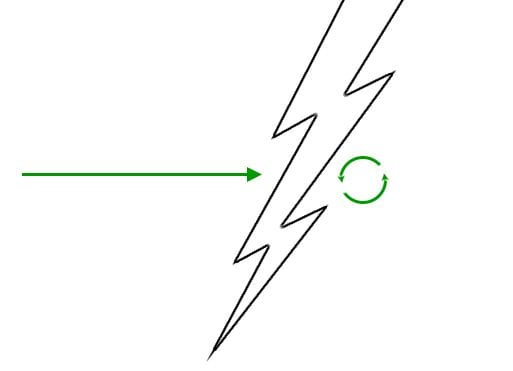
A character’s energy needs a shock to its system to be restarted. It’s what Dale eventually understood when he put that fork in the socket in Part 15: he needed to restart his energy flow as part of the system of natural energy that he knew he wanted to be a part of again.
His cycle looks like this:
 In a more general terms, I’ve broken down the stages each character uses to process their trauma:
In a more general terms, I’ve broken down the stages each character uses to process their trauma:
 And then I’ve matched it up to the timeline of Cooper’s time loops, per Cooper’s greater arc of processing the trauma he incurred when he entered the Lodge (each of his time loops represent a stage of the trauma cycle):
And then I’ve matched it up to the timeline of Cooper’s time loops, per Cooper’s greater arc of processing the trauma he incurred when he entered the Lodge (each of his time loops represent a stage of the trauma cycle):

Dale’s point of trauma in this case is the Episode 29 events in the Waiting Room. The moment that restarts his energy from that point is not the fork (that was a smaller point of understanding) but “what year is this?” Understanding that he’s disconnected from time is a trauma that Jeffries went through and that Dale is now going through. Dale is at a precipice in the final credits. Will he decide (at all) if he’ll use his energy for the positive, re-embrace the timeline and repent for the trauma he caused to the timeline during his loops (much as Ben Horne did in The Final Dossier for inviting the prison into the Twin Peaks area when he sold his land, and now tries to help where he can whenever he can) or will Dale choose to become a monster in the vein of like Phillip Jeffries, or be like Sarah Palmer, feeling like she must have been a monster and therefore invited a monster inside her retroactively.
Will Carrie’s scream wake Dale up (“Finally!”) or will he stay in the dark dream like little Denny Craig, who per Maggie in Part 4 took Sparkle, the bell rang (what was supposed to shock Denny’s system awake), and he just never woke up?
Last time, I focused mostly on Margaret’s words in Part 10 about a dream flowing like a river at her. This time I’ll be focusing on Lucy’s words about which Truman that Insurance Salesman wants to see, and Hawk’s words to Frank about the intention behind the fire, which I equate to the intention of your energy showing you the Timeline or Lodgespace.
Travelers and passengers
Margaret Coulson, in Final Dossier, spoke of passengers and travelers, and striving to be a traveler because a traveler embraces and fosters Light, both in oneself and in others.
I include this, which was from the Final Dossier Deep Dive here on 25YL:
Don’t be sad. Be happy to have another day to do what needs doing.” It implies sadness is an emotion associated with being stuck in place. She goes on to say there is no light without darkness and we should make peace with that. And, whether we see that as a metaphor or fact “both tell us that time—and light, and darkness—move in cycles. We move through them, too, often as passengers, but if our eyes are open, there is much to be learned along the way. A traveler learns more than a passenger. When darkness comes, a traveler learns to be brave, for they know the light will return.
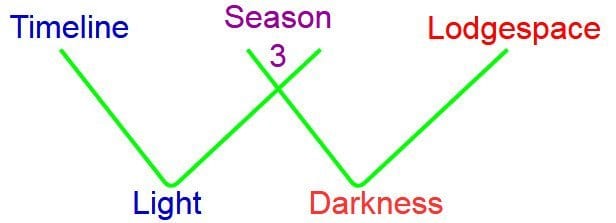 Much as Cooper is going through the stages of trauma, or being asleep, everyone in Season 3 is one of the people Margaret speaks of in Final Dossier.
Much as Cooper is going through the stages of trauma, or being asleep, everyone in Season 3 is one of the people Margaret speaks of in Final Dossier.
Travelers know who they are and are heading for the Timeline.
Passengers don’t take responsibility to know themselves and they allow darkness to cover them. Their energy remains stagnant when their bell rings.
In terms of fitting the concept of travelers and passengers next to Season 3 concepts, I give you these associations:
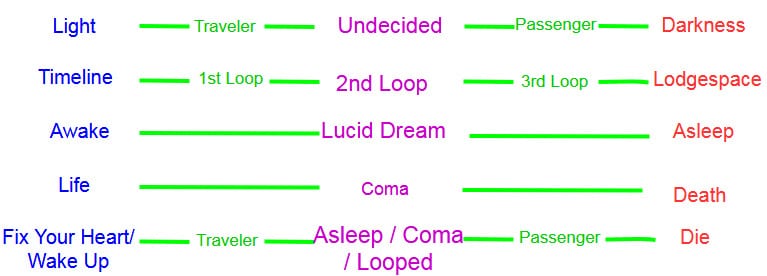
Most people in Season 3 spend time as both travelers and passengers, oscillating between the two outlooks not unlike that clock in the sheriff department unable to move backward to 2:52 (which would be 3rd Loop in this metaphor) or forward to 2:53 (1st loop), spending most of its energy in between them (2nd Loop). We also see this metaphor in the arm wrestling scene. It’s more comfortable to go back to the starting position of indecision.
Oscillations keep characters spinning in place, stuck in loops, or otherwise unable to break through to win the match or make the clock hands move all the way. How does someone punch the resistance in the face, so you can break through the logjam (or negativity) holding you in place?
By fixing your heart.
Next: Golden Shovels
When you’re stuck in place processing trauma, how do you go about fixing your heart rather than dying? This Twin Peaks theory thinks you do it with the tool introduced in the very first non-Lodgespace scene of Season 3: the golden shovel. And I assure you, the two coats(!) are absolutely necessary.
Golden Shovels
 In Part 1 we saw the shovels arrive but didn’t know what they were or where they were going. All we knew by the end of the extended scene was that Jacoby wanted this delivery.
In Part 1 we saw the shovels arrive but didn’t know what they were or where they were going. All we knew by the end of the extended scene was that Jacoby wanted this delivery.
The next time we see the shovels, Jacoby is in his properly protective gear spraying a coat of paint.
Then we finally see Jacoby in his full Dr. Amp glory and we’re laughing our asses off. that’s what the shovels were for??
But then we see more Dr. Amp shows, and we even see the commercial again. And we feel the message in a different light.
Then we see Nadine using the advice in her own life and it bankshots into Ed and Norma getting together.
Think of the feelings evoked in you when you first watched these scenes as we look again at the shovel stages, this time against the thematically similar message of help delivered to Bobby in Major Briggs’ message pod. The pod contains a message which also involves a slow-reveal process just to see the message, and in its way the pod is also a physical microcosm of the path from trauma to understanding:
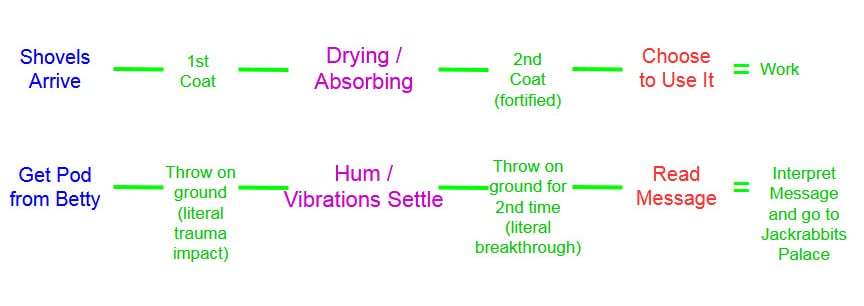
For yet more similarities, let’s line the shovel stages up against Dale’s chronological timeline, as well as the trauma cycle:
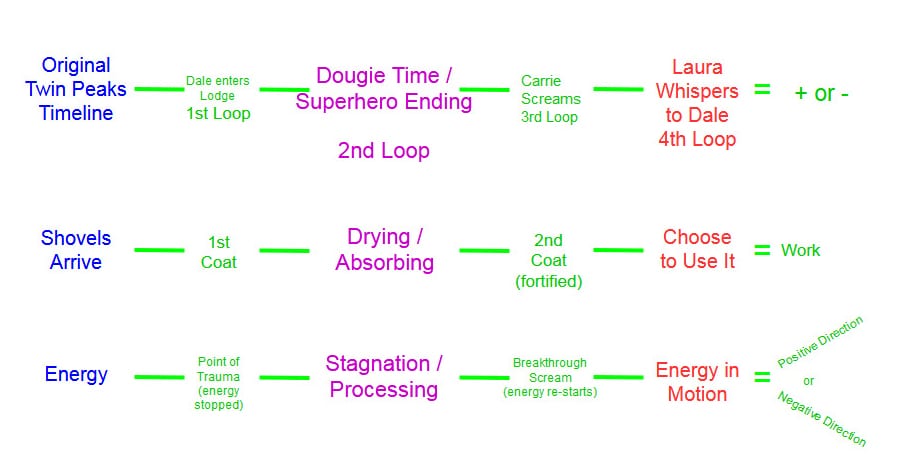
If you use a golden shovel, you choose positive energy. You choose life. You choose to be a traveler.
The process of readying the shovels mirrors how Dr. Jacoby readied himself, including two moves from Twin Peaks to Hawaii placed exactly even with where the shovels would be getting their gold coats:

Jacoby’s reason to first go to Hawaii was because his father was stationed there. He was also separated from his brother and father, who returned to Twin Peaks much earlier than he did. This lines up with a point of trauma, so perhaps the division of his family was an equivalent event in his life.
Eventually, after some spiritual quests (where per The Secret History of Twin Peaks he met a number of creatures that appeared to look like the Fireman) he returned to Twin Peaks, where he tried to help people as a psychologist but ended up not helping Laura Palmer at all. Near the end of SHoTP, as he realizes he’ll probably lose his license to practice, he says this:
But the truth is Laura’s death has broken me. My own belief system—the fantasy that I could hold these worlds in balance—inner life, outer reality—and bring the truth of one closer to the other, like some free-thinking hippie Prometheus, is shattered. What a hapless fool I’ve been. Actions have consequences. Whatever happens from here, whatever the squares decide about my professional fate, if I can survive this ordeal, find the strength to dig my way out of it, I make this vow: no more lies. Only truth. Straight up. To everyone.
This is most definitely Jacoby’s breakthrough point, and the reason he leaves for Hawaii for a second time. This matches up with the second coat, and the point where people scream to restart their stagnant energy.
From this point forward, Jacoby began learning all he could about helping people in multiple studies, and eventually he created his Dr. Amp persona and the golden shovel metaphor. This is how he was going to help. He wanted to help people reach the same conclusion he did: that living within a deception where actions don’t have consequences is not the answer. He needed to dig himself out of the shit. And he wanted to become a proverbial golden shovel to help others start their own process.
If you choose to use a shovel, it looks like this:

Call For Help
Jacoby almost literally became a golden shovel for Nadine. Let’s look at Nadine’s Season 3 arc matched up with the trauma cycle, as well as to the shovels:

Continuing to follow the bankshot, let’s look at how Ed is released by Nadine in Part 15, then goes through his own evolution:

There’s more of this helping pattern than just the straight line from Jacoby’s help. It appears every character connected to the Fireman finds a way to help someone. Carl Rodd, for example, helps the hit and run mom in her moment of need; his compassion frees her from being stuck in a loop of despair. Positive energy directed towards someone else is the help that allows the other person’s energy to begin moving again. And their energy can resume being part of the energy cycle between material and non-material universes or whatever you want to call it.
If I had to explain the full shape of a trauma cycle, it’d look like this:
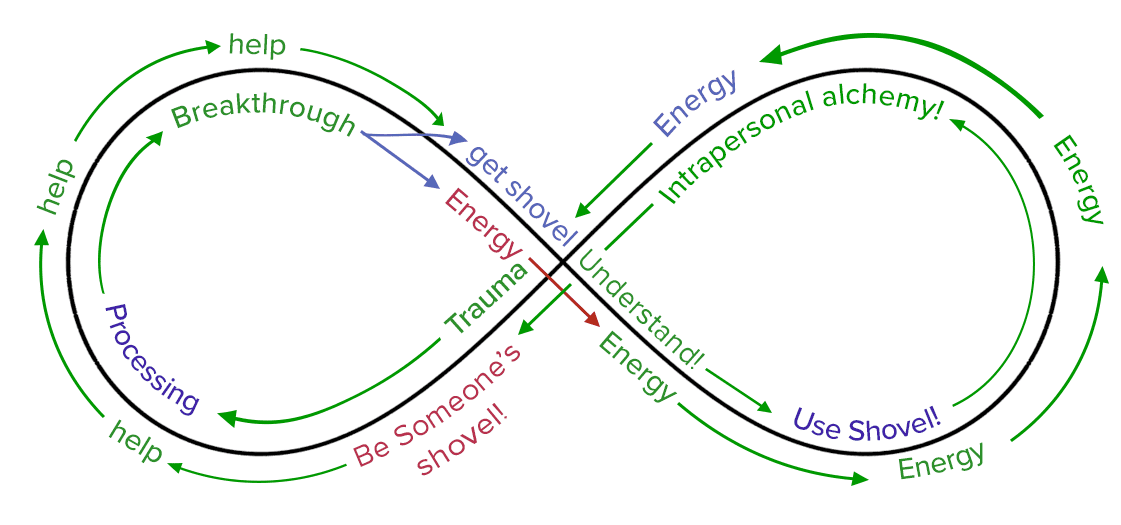
I think Dale, as a full-on magician in Part 17, thinks he’s doing this kind of work:

Except he’s only in loop 3 at the time. He’s only here:

Dale thinks he’s helping, I honestly think that, but he is “far away.” He doesn’t even have his shovel yet. He needs to reach a certain point alchemy-wise to do the kind of magic he’s trying to do. Just like Jack Parson with his Thelema magic and the other ring wearers in Secret History of Twin Peaks, Dale’s hubris is outrunning his alchemic state.
Though really, it doesn’t mean Dale isn’t helping Laura anyway, it’s probably just not how he thinks he’s helping. After all, people being incremental shovelfuls of golden help along the way is exactly how help works in Season 3.Just ask Janey-E
Help, Delivered Incrementally
In Part 4, Lodge symbols hover over slot machines ready to hit jackpots for Dougie. Then Bill and Candy Shaker give him enough info to find where he lives, and Supervisor Burns reluctantly gives him his winnings and authorizes a limo ride home. So this gets Cooper-as-Dougie home to Janey-E, who receives the money and understands that she can pay for all the debts Dougie accrued that caused Janey-E nothing but trauma and stress. She was released by this money and then slowly but surely became more and more present and loving towards Dougie.
Here’s a quote from my Part 4 Rewatch article on the subject:
What we see in this casino portion of Part 4 is a number of small incrementally helpful steps from a number of people, little steps that on their own don’t go too far, that add up to Cooper-as-Dougie arriving at a location he initially didn’t know about with enough money in hand to pay for the previous debts of Dougie Jones. Call for help, indeed.
This is also a microcosm of how the plan to stop DoppelCooper comes together: The Log Lady helps Hawk to the Diary pages, which leads Bobby to the chair, which leads to Andy getting an audience with the Fireman, which leads to Lucy shooting DoppelCooper, which leads to Freddy knocking the BOB orb apart. There are no main heroes in this story, more so many people having smaller moments of heroism that add together into the positive energy that can overwhelm the darkness, or at least, as in the casino scene’s case, bring forth the light to those in need.
Honestly, compassion and everything related to help that Janey-E mentioned in her “we are the 99%” monologue is positive energy, but it’s also rooted in Love, which is called a key that “open[s] the door” back in Season 2. And negative energy can easily be equated with Fear, the other door key.
Sometimes help isn’t enough
Just because help is offered doesn’t mean characters will take the help, though. Just ask Hawk. He offered help to Sarah Palmer and had plenty of compassion when doing so, but the compassion must be accepted. Sarah basically growled at him and closed the door.
Season 3 is made out of choices that can fix your heart, but you can also make choices to—however soon—die. The choices can go in both positive and negative directions. And no better is this on display than the scenes at the Roadhouse.
Characters at the point of a breakthrough use the Roadhouse as a junction point
Not only is the Roadhouse a junction point between realities within the story itself, it is also a junction point of theme. It display three states of reality for us to use as a compass, and it also consistently shows us characters that accept or refuse personal responsibility, thus changing which frequency of reality they exist in.
Each random we’ll-never-see-them-again character in the Roadhouse is either on the precipice of their own breakthrough moment like Audrey, or they’re there—whether to be a golden shovel or more weight—to help someone make a decision to direct their restarted energy positively or negatively.
I look into this more deeply in How The Roadhouse Works in Season 3, but I will explain it concisely here in terms of Cooper’s time loops as the frequencies to tune to. The Roadhouse has the ability to step out into the positive Timeline-adjacent 1st time loop frequency, or into his negative Lodgespace-adjacent 3rd time loop frequency. Which frequency we are shown depends on the establishing shot(s) of each Roadhouse scene.
- The parking lot – tunes to the in-between state (the 2nd Loop)
- The Bang Bang Bar sign – tunes toward the Timeline (by way of the 1st Loop)
- The Sign reflected in a puddle – tunes toward Lodgespace (by way of the 3rd Loop)
- If the parking lot is mixed with one of the signs, I think it connotes a shifting from the Timeline toward the in-between state, or from the in-between state toward Lodgespace.
The Timeline-Adjacent Positive Frequency
Roadhouse scenes that begin with the Bang Bang Bar sign begin with a positive energy frequency. This is tuned to Cooper’s 1st Time Loop.
In Part 2, the parking lot is included in the establishing shot. Shelly and her friends are there as well as James and Freddie, and even Red and his finger guns. It seems like most things are normal, though the Owl Ring is present on the Chromatics’ guitarist, and Shelly voices that possible reversal “James has always been cool.” Why the parking lot along with the sign? As it’s the episode where Dale’s 1st Loop ends and 2nd Loop begins, the symbolic angle could be the tuning from the Timeline officially into the in-between state.
In Part 4, we only see Au Revoir Simone play. They are lit in purple light.
In Part 12, Abbie and Natalie at the booth are looking for Angela, who’s on the edge and off her meds and has been hanging out with (and dreaming of) a two-timer by the name of Clark. Angela’s off-balance and her friends mention she’s dreaming, however literally they mean. Angela’s not there because the bar and the women are tuned towards Loop 1 while Angela’s tuned negatively towards 3rd Loop. The ladies’ friend Trick shows up after almost being in a head-on collision with a car going the wrong way. He’s just out of house arrest, may have experienced a reversal as he arrived to the same positive tuning as his friends. After all, he’s just out of house arrest (a stagnation period) and that’s behind him now. He’s shoveled himself out of the shit. They’re heading to the Timeline.
In Part 14, Sophie is acting like a shovel for her friend Megan, who talks about a time she saw Billy bleeding out of his mouth, but then can’t remember the rest. It’s like she woke up from a dream; like she just stopped tuning towards Lodgespace for good. Right at this revelation, Lissie starts singing triumphantly with a lot of energy and her lighting is only yellow: a state of achieved intrapersonal alchemy personified by a scene, if you ask me.
Part 15 also includes the parking lot. It moves from being tuned towards the Timeline into being tuned in the middle when James and Freddie interrupt the otherwise banal scene of Renee, Chuck and their friends. When it really tunes towards Lodgespace-adjacency? When Freddie uses his glove and the music skips (two punches!). Later on we see a shot of the parking lot, where you could say it’s still tuned to the middle state, but then transitions to tuning towards Lodgespace as Ruby (whose energy is stuck in place as she’s waiting for someone) crawls along the floor and begins screaming (her breaking point) as the strobe light kicks in and it is implied she caves in to Lodgespace.
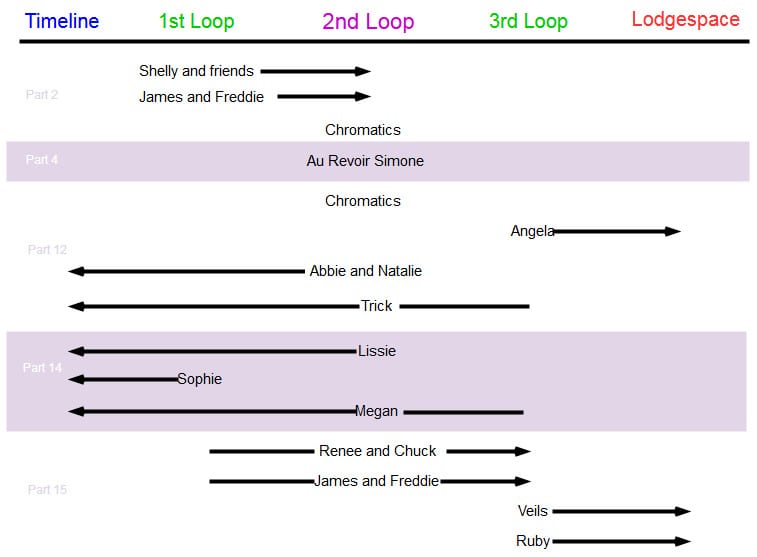
The Lodgespace-Adjacent Negative Frequency
Roadhouse scenes that begin with the Bang Bang Bar sign reflected in the puddle begin with a negative energy frequency. This is tuned to Cooper’s 3rd Time Loop.
When Dale gets lost in the 3rd Loop, he begins to become unrecognizable, known as Richard while Diane is known as Linda. They become part of the well-established name salad (Chuck and Tina and Billy, etc.) that is well on display during these Roadhouse scenes.
Billy is an indicator of Lodgespace presence. He’s not a character per se but he is a landmark as the story proverbially drives through that part of town. The random characters who knew him either choose to step away from his drama, therefore tuning to 1st Loop on their way to the Timeline, or they stay tuned into Billy’s kind of drama towards the 3rd Loop on their way to Lodgespace.
In Part 3, we just see the Cactus Blossoms. They’re lit in blue with yellow lighting behind them, which I’d say is traditionally positive Timeline-leaning imagery. Is the visual code saying that Timeline and Lodgespace tuning exists together all at once?
In Part 5, we see a person walk straight through the reflection. The next thing we see is Richard Horne, so that’s easy to see as code for “we are now entering from the in-between into Lodge-adjacency.” Between his parentage and actions, it’s nearly impossible to argue. How else? The girl and her friends are frozen with inaction even as he threatens vile things I refuse to type here.
In Part 9, we meet Chloe and Ella. Both are talking in sparkle drug code about animals, and rash girl got fired and started the same exact job across the street. Sounds like a reversal that she noticed but didn’t understand, and that the two girls were going to continue this descent into Lodgespace darkness without even comprehending what they’re only barely noticing.
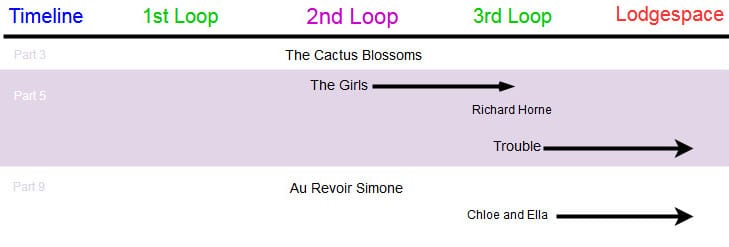
The In-Between Frequency
Roadhouse scenes that begin with the parking lot establishing shot begin with a neutral or stalled state of energy frequency. This is tuned to Cooper’s 2nd Time Loop.
In Part 6, we just see Sharon Van Etton perform. She’s lit in blue and the curtains behind her are a purplish red.
In Part 7, it goes to the sweeping scene where we are likely seeing the Timeline symbolically swept away by the man sweeping the floor (with the red stage curtains looming in the back corner of the shot), clearing the space for what will come starting with Jean-Michele Renault’s call about high school girls, then the diner patron flip in the credits, then what must have always been in Part 8.
In Part 10, the Roadhouse is preceded by the foggy moon. Rebekah Del Rio sings No Stars against purple/red curtains.
In Part 13, James is lit in purple, as if he’s finding his proper balance, and we see Renee crying.
In Part 16, we see Eddie Vedder’s shadow first, then him. The rest of the stage is black except for his spotlight, and there’s some purple curtains in the light. Audrey and Charlie arrive and Audrey toasts to Billy, then dances to her named “Audrey’s Dance” from the original Twin Peaks Soundtrack—a previously-mentioned sign of Timeline presence. This is Audrey being completely tuned to the Timeline, up to and including Eddie Vedder billed as his birth name (rather than the name we all know). Then, a fight breaks out and Audrey begs Charlie to get her “out of here”, and while she is in the white room with the mirror, the Roadhouse plays her song backwards in a full reflection of what they just played. Though Audrey’s frequency is much more complicated—we’ll look into that next—the Roadhouse itself could plausibly be tuned to the 3rd Loop at this point.
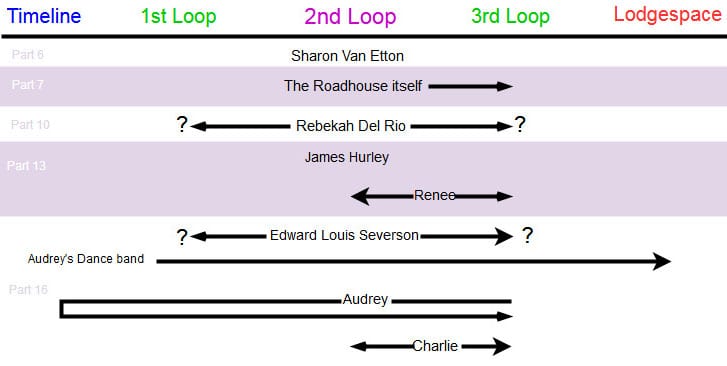
Next up: how the characters in Season 3 are shown going through their trauma cycles
Now that this Twin Peaks theory has looked into Twin Peaks reality and how to navigate it, it’s time to put it all together. It’s time to look at the cases of some prominent Season 3 characters.
Audrey
If I’m correct about Billy being an indicator of Lodgespace presence, this means his lover Audrey is trapped in a zone tuned to Lodgespace.
I mention this in Part 3 of my Final Dossier Deep Dive:
Her trauma is both tied to her father, which she seems to overcome by living a simple life and going into business on her own, but also to Dale Cooper’s Double. And as with Annie Blackburn and Harry Truman later on, she could not overcome the trauma incurred by her proximity to Lodgespace, and she remains trapped by it. This seems very much like how her father is trapped by pushing against the prison [that arrived when he sold the land to a shady unnamed company]’s darkness his whole life, except hers is on a spiritual/metaphorical level.
In Season 3 we see Audrey trying to tune from the 3rd Loop she’s synced with to the middle 2nd Loop where the Roadhouse naturally exists within Cooper’s loop tuning order.
Her trauma began with the bank explosion and rape by DoppelCooper. We see her stuck in her stagnant period; literally repeating the same scene with Charlie using different words, though her breakthrough moment of restarting her energy is when she screams “I hate you!” while attempting to strangle Charlie. This breaks her energy out of its stasis and she actually arrives in the 2nd Loop tuning and the Roadhouse. When she dances to “Audrey’s Dance”, this is Audrey being tuned to the 1st Loop for the first time in a long time.
She can almost feel the Timeline—almost chooses to send her energy in a positive direction—but then her song is interrupted by violence spurned on from strangers’ revealed infidelities (a major repeating theme in Final Dossier by the way), and she chooses to have Charlie get her out of there.
Which means she chooses to return to a negatively charged situation. It does not mean she’s chosen it for good; more so it implies a stalemate.
She can’t get out of her darkness quite yet, but now she’s gotten a taste of the 1st Loop. She’s seen part of the 1st Loop, therefore in the end of Part 16 we can see her body in what appears to be the real world, but the face we see speaking is the one in the frame of the mirror. Which means to me she’s officially fragmented. She has more darkness to push through, but she’s gotten through further than she has in a long time. And she’s not entirely tuned to 3rd Loop anymore; it looks like she’s just as much tuned to the 1st loop (in a way just like she is in Final Dossier), like she’s splitting the difference and hovering around the middle state of reality but never within it. But, since the bank explosion, she’s closer than she’s ever been.
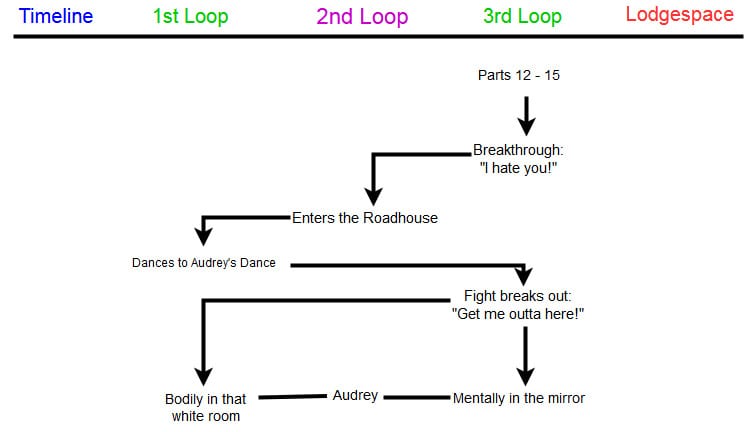
Norma
An example of dipping into the darkness before turning it around at the last second? Norma.
In the early parts of Season 3, we see Norma mostly doing the Double R’s books in looped footage. She wants to help Shelly with Becky in a Part 5 scene but doesn’t do more than listen (because per pattern of help cannot be forced, merely offered until accepted). Otherwise, it’s mostly her sitting in that booth doing the books.
Per Final Dossier, she puts her entire life into her business rather than her personal life, therefore the Double R is on the same frequency as Norma. That’s why, when she’s so buried and resigned by her lack of self, the entire diner tunes toward the 3rd Loop at the end of Part 7. That was when Bing pokes his head in and asks if anyone has seen Billy, again a signpost of Lodge presence.
By Part 11, the Diner’s tuned to the darker loop so much that Shelly goes back to bad boys over family, gunshots break through the windows, and people just outside drive zombies to dinner dates and lay on the horn.
In Part 13 we meet Walter, the symbol of the corporation that’s trying to turn Norma’s tried and true recipe for spiritual success into a standard money-hunting franchise. And the natural, organic, local ingredients that go into Norma’s pie are literally under fire for being too expensive. “You make them with love,” Walter says facetiously. “You’re a real artist, but love doesn’t always turn a profit.” The choice between the negative force of profit or the positive force of love is literally in play (I won’t even bring up how this is also David Lynch’s thought process on making movies and the Hollywood system because it’s already obvious which choice is positive and which is negative in his eyes).
But then in Part 15 Norma breaks through. She knows what’s causing the darkness. She hits her breaking point the same time Ed does. She releases herself from Walter and his business contract, and next thing you see is light breaking through the trees overhead of the Double R. How do we know this is Norma tuning to 1st Loop and then through to the Timeline? We never see her again in the show. Also, the Diner looks completely unattended when Dale and Carrie pass by it in Part 18 while within the 3rd Loop. She doesn’t belong near the “dream” anymore because she woke up. She fixed her heart.

Sarah Palmer
During the Part 12 grocery store scene, the same soundscape is used that was playing during Phillip Jeffries’ original FWWM scene (at the exact moment when he realizes he may be unstuck from time). What is happening to Sarah at this moment? She is realizing she’s being/has been re-tuned. And this is what I’d consider her breaking point, which we’ve established matches really well with Dale’s breaking point.
Were you here when they first came?
Your room seems different, and men are coming.
She’s talking about turkey jerky looking different. I assume a similar switch happened here as happened to the Double R patrons in Part 7, and Sarah’s so Lodgespace-tuned she can recognize the change. She could feel the “dream” coming at her like a river too (after all, she’s one of the gifted and the damned). The wave of the Lodgespace “dream” that hit in Part 7 seems like it began changing her before Part 12; plausibly during her origin in Part 8.
Here’s more from Part 12:
I am trying to tell you, that you have to watch out. Things can happen. Something happened to me. Something happened to me. I don’t feel good. I don’t feel good. Sarah, Sarah, stop, stop doing this. Stop doing this. Stop doing this. Leave this place. Find the car key. Find the car key. Get the car key. Get the car—get the god damn car key.
The repeating words really stand out typed like this. I know I’ve called this behavior PTSD before, and I still mean it, but the metaphor associated with repeating phrases leans towards looping; though it could also be that she is oscillating back and forth between loop frequencies. She could be saying the same thing on two different frequencies as she oscillates at her breaking point between 1st Loop and 3rd Loop tuning. She knows she needs to get away from where she is so she can calm down, but it ends up sounding a lot like Audrey’s “get me out of here”. It makes sense they’d be thematically linked, as they both literally gave birth to an actual child made at least in part of Lodge darkness.
Sarah’s breaking point does not bring out her strength like it does with Audrey. Sarah is not that kind of fighter. She instead later watches boxers on TV (a passive activity when she should be actively fighting for herself), and during a knockout punch the TV likely becomes a conduit for Experiment Model to take her over as I suggested in Coordinates (ft. the roving #6 Telephone Pole, Palmer Houses, Two Birds and a Stone). And the knockout punch was to Sarah, falling victim likely to Experiment Model.
How could she have pushed against the darkness? In that same Electricity Nexus I said DoppelCooper uses the coordinates to find the junction point that will take him to the Palmer House in Part 12, which immediately follows the grocery store scene. Instead of DoppelCooper meeting her, this is when Hawk meets Sarah, offers her help, and she refuses it, saying instead how it’s “a goddamn bad story.” Which matches up with other Lodgespace/3rd Loop-tuned folks talking about the story of the little girl who lived down the lane. Stories are not much different than dreams, and the “dream” is what Margaret warned Hawk about in Part 10. Hawk was tuned to 2nd Loop when he visited Sarah in Part 12 (and again we see an offer of help that could not move forward unless someone accepted said help), while Sarah was already talking in 3rd Loop tuning. Whether that sound in the kitchen was Experiment Model waiting for her or the grocery store bagboy stocking her kitchen with left-behind groceries, she was already tuned with negative energy in mind, ready to believe in a story instead of the life she lived. And hence we have Sarah meet the “Truck You” guy in a bar that belongs about as well as Sarah’s new nesting creature.
And what sealed Sarah’s fate? When did she make her decision to go full Lodgespace? When she tried to destroy the homecoming photo in Part 17. Despite her ability to remember everything from before and after re-tunings, and whether or not it was possible to do so, she actively chose to destroy the Timeline symbol of all Timeline symbols from her own house. And if that isn’t a definitive decision I don’t know what is.
From that moment we never see her again. We even needed new homeowners to sub in for her in Part 18, even as the house remembers Sarah’s voice. She chose the full “dream,” the darkness, and couldn’t come back to the 3rd Loop.

Lucy
Back to the lighter side of things, Lucy’s energy restarted at her breaking point, which involved two things from Part 4: her scream when she didn’t understand Frank’s sudden arrival, and Wally releasing her from maintaining his bedroom in what should be a study (this is the equivalent of Janey-E getting that money that released her from Dougie’s financial debts). In Part 9 she and Andy begin to make that study a reality by choosing a chair (from a motivation of love), and she even takes time for herself by making sure no one interrupts her on her lunch break. In Part 10, she tells Chad about a time when a clock stops, alluding to Part 17 when she chooses once and for all to intend her energy to the positive when she literally kills a force of darkness in DoppelCooper.
This is where Lucy’s tuning and her timepiece necklaces fit in; Kylee Karre of Between Two Worlds Facebook group discovered the timing when she was looking for multiple timelines, but it works well in this tuning theory as well. While Lucy’s stuck in place, she wears one timepiece. When she begins to move forward in Part 9 (and her energy is beginning to move), she’s tuned to the 2nd Loop and wearing two timepiece necklaces. Then when she shoots DoppelCooper she’s back to wearing one timepiece necklace, signifying she’s returned to being in the 1st Loop but this time by choice rather than being frozen in place there.

Dale was at the same point as Lucy’s Part 4 scream when he stuck a fork in the socket. You can see Dale’s energy flowing when he has a lapel pin on, but when his energy is stagnant and stuck in the 2nd Loop there’s no lapel pin. After that fork, his next scene is him waking up, with lapel pin present.
Even if you can connect the fork and the scream, remember it took Lucy 13 full parts to go from her energy moving to her decision to use it in a positive direction. It seems Dale’s got a ways to go beyond Part 18 (while still far away) before he has a true understanding to factor into a proper decision. Until then there could be any number of ups and downs, energy flowing or not.
I don’t think he’s lost to the darkness at all, no matter how bleak things felt in the end. Donna Hayward, in Final Dossier, was so entrenched in the darkness she needed a fourth stint in rehab before she turned her life around, but she did, and simplified while studying to be a nurse practitioner. She chose light almost after it was too late but she did it. If Dale needs the 4th Loop that begins in the final credits to properly choose light, then I’ll count Donna’s situation as precedent.
Becky and Steven
The best explanation of what happens when you tune yourself completely away from the 2nd Loop’s in-between zone comes from Becky and Steven, who (in addition to never being seen by us again) literally cannot see each other by the end of Season 3 despite both still being in the show—Becky’s tuned to 1st Loop and Steven’s tuned to 3rd Loop. And they can’t see each other at all. They’re standing next to each other looking in different directions.
Becky, in Part 5, hides from her problems in Sparkle and hears “I Love How You Love Me” playing while she is literally a passenger in the car. She tries to believe she has love with Steven, while Steven can’t get a job and turns Mike Nelson’s negative critique into “good feedback.”
In Part 10, we see Steven ready to take a swing at Becky. She’s fearful but not necessarily surprised. And Steven throws a coffee cup out the window. As I’ve mentioned in the previous part that coffee is a visual symbol of the Timeline, this is Steven literally throwing that symbol out of the place where he lives, essentially choosing darkness right then and there.
In Part 11, Becky’s breaking point happens with a scream and gunshots into Gersten Hayward’s apartment door. This unsticks her energy and she begins saying no more to Steven’s treatment of her. She also gets help from Bobby when he loans her the money to pay for the damage she did to the door, and this is the clean break from her trauma’s damage that she needs to restart and reset her energy. Meanwhile, Steven was there down some stairs at a different level altogether, literally and figuratively.
In Part 13, Steven’s been gone for two days, according to what Becky says to Shelly over the phone. The Part 11 call to Shelly (before the gunshots) could’ve been a tuning from 3rd Loop to 2nd Loop, but this call is definitely from 2nd Loop to 1st Loop as Becky is well on her way back to the Timeline. What seals the deal? Agreeing to go to the Double R and have pie with Shelly. The exact invitation, by the way, that could’ve brought Hawk to the Timeline if he’d taken Margaret up on her offer in Part 2 is exactly what Becky chooses for herself with Shelly and we never see her again. Tuned to positive energy, to the Timeline.
In Part 15, we see Steven and Gersten tripping out of their minds, heavily into the 3rd Loop tuning that involves nonsense words, and they’re literally lost in the woods. They keep talking about animals, as is customary with people hooked on Sparkle. He chose the darkness, Lodgespace. He chose to look far from the Timeline, so he doesn’t see Becky anymore. He kills himself in Season 3, but per Final Dossier both he and Gersten have disappeared, not died. (Tell me that doesn’t sound like the Laura Palmer ret-con in a nutshell.) They’ve been swallowed up by Lodgespace because they became passengers rather than travelers like Becky. Disappeared, just like Sarah Palmer wasn’t in her house anymore. You choose the darkness and you won’t be participating in any part of the material universe, even in the “dream.” You’re just enveloped.

Diane and Laura
In How the Fireman “Brings Back Some Memories” I made a case for how a tulpa is a physically manifested memory of trauma unable to rest until it processes what happened to its body. In this case Carrie Page was created upon Laura Palmer’s murder and Diane’s tulpa would be created when Diane likely died in the Convenience store after DoppelCooper brought her there in the memory she recounted to the Blue Rose Task Force in Part 16. I made the case that the Carrie and Diane tulpas needed to reach a certain understanding before their original selves could go onto their next stage (say heaven or the like).
I still believe this is probably the case, but I could also believe that Dale Cooper could be part of their creation when Laura and Diane were no longer in the picture because he still needed them to play roles in his Lodge loops. In this case they are still plausibly memories of traumatic events, but perhaps their genesis is being sparked by a magician after they’ve already died.
I would also not be shocked if their states as Naido (Diane) and American Girl (Laura, which though unprovable I make a case for in Permutations of American Girl) were created to house the true versions of Diane and Laura so that:
- The tulpas could exist (traditional takes on the tulpa concept need a living identity to create the thought forms).
- The women’s actual souls would not be attached to the in-between state of reality formed by Dale.
Either way, the purple zone roommates end up feeling like they’re in a witness protection program of the White Lodge (and I apparently can’t let go of as a concept since I wrote about it in Laura Palmer is in the Lodge’s Witness Protection Program in a life modeled after Shelly Johnson.)
Structurally, Laura and Diane’s stories are nearly impenetrable, and as I’ve just proven, you can plausibly go many ways with their plots. But I’ve already explored how their roles work within the structure of reality that I’ve described in the five parts of this unified theory. You can find that exploration in Why Diane and Laura are the Heroes of Twin Peaks. I encourage you to read it if you’d like to know these women’s places in this stacked reality, for instance what Laura’s three screams mean in regards to her breakthrough moment.
In short, I describe their actions as protagonist-adjacent as they are actively trying to untie themselves from this “dream” (at least as of Part 18) so they can return to wherever it is they really belong. I also suggest that if they are able to remove themselves from Dale’s in-between reality state, which I believe they are doing in both active and subconscious ways throughout Season 3, that maybe no one will be there to anchor Dale Cooper (using sight as a tool of object permanence) within the in-between state. If this is true, and Laura and Diane do not tie Dale to the “dream” by seeing him in it, Dale will then unravel from his Lodge loops. And he’s removed from his Lodge loops, therefore Lodgespace and Timeline will separate properly and fall into balance once more beginning with Dale’s 4th Loop.
Next: Dale Cooper navigates Season 3
This Twin Peaks theory has finally arrived at the big questions: Was Dale Cooper following a plan? Did he take away Laura Palmer’s agency and/or blow up reality as Twin Peaks knows it? Is he dead?
Every interpretation of these questions’ answers seems to hinge on how you view Dale Cooper’s decisions to do what he did in Parts 17 and 18 of Season 3.
Dale Cooper
Two trauma cycles
From the point of view of Dale within his “is it future, or is it past” loops, he’s within this kind of trauma cycle:

Being possessed would be a most excellent example of a major trauma that stops Dale’s energy in place. You can see him being in a state of hibernation in the Waiting Room. You can see his Dougie version as a pure receptacle of stalled energy. You can see Dale’s energy starting up again when he stuck that fork in the socket (complete with Janey-E’s not-understanding scream in the room), then becoming himself in Part 16 before he takes the path of constantly helping people (however suspect his methods may appear). You can really see him trying to be a golden shovel for people, from Diane to the Judy’s Diner waitress to Carrie Page. Except through it all he’s cold, fairly heartless, and lacking intuition as he does it. All of us fans agree in some capacity that Dale is a different guy, and probably missing something. Or at least he’s still calibrating as I say in The Dale/Mr. C showdown begins in Part 18 when Dale becomes DoppelCooper.
But I think the BOB-related trauma is only so much of the picture, and isn’t the focus of Dale’s trauma cycle as he intuitively seems to think it is. Much as Audrey had two levels of trauma, so too does Dale.
Audrey’s traumas are:
- her real world trauma focused around her relationship with Ben Horne, which she overcame.
- her Lodgespace-related trauma begun with her rape by DoppelCooper which led—just like with Sarah Palmer—to her birthing a child who was half Lodge. She had not overcome this at the beginning of Season 3.
While Dale’s traumas look like this:
- BOB-related trauma, solved completely within Season 3, culminating in Part 17.
- Then there’s the deeper trauma of losing all those years, as Andrew Grevas discussed well in Agent Cooper: My Thoughts & Theories on His Journey Throughout the Series. Dale’s is a deeper, longer-term trauma expressed best when he shed a tear through Dougie likely over the fact that he didn’t have a child of his own, and the child that he had was unknown to him.
Cooper’s BOB-related trauma cycle is entirely associated with the loops that begin with Phillip Gerard saying “Is it future, or is it past?”
This second, deeper-level trauma cycle of Cooper’s is the one that repeats with the Laura whispers.
Let’s Look at Dale’s loops chronologically again in this context:

What does this mean?
Dale went through three cycles of Laura whispering to him:
- The first cycle began with his Red Room dream from Episode 2 and ended with Dale entering the Lodge and “Meanwhile.”
- The second cycle began with Dale needing to choose whether to tune to Laura’s whisper or to Phillip’s “Is it future, or is it past.” Instead of choosing to “go now,” Dale chooses to do the three Phillip loops within this second whisper loop.
- The third cycle begins in the Part 18 credits with Laura again whispering to Dale. Hopefully Laura will sit Down next to Dale and once again say “You can go out now,” and this time he’ll do it. Because if this cycle of Laura whispers follow the same pattern as the other trauma cycles, it would match up just like this:
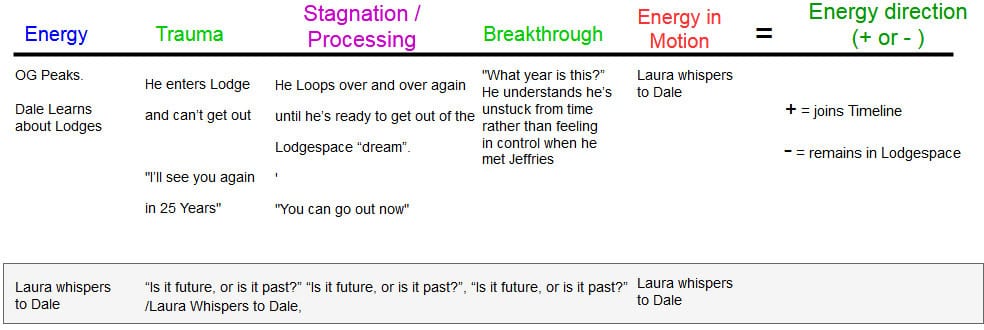
Put most simply, the first cycle goes from the Timeline into the Lodge, the second cycle is from within the Lodge, and the third cycle goes from the Lodge back to the Timeline. Visually speaking, it’s personified by the shape of Cooper’s lodge loops:

Recalibrating the metaphor to tie Dale’s trauma cycle to the Laura whispers, Dale chooses to follow a darker frequency like Norma and the Diner did between Parts 7 and 15 before he reaches the possibility for a similar re-tuning to more positive pastures at the end of Part 18. For one thing, the Laura Whispers cycles are literally part of the Timeline. The sun can still shine through in Dale’s next unseen scene just like it did outside the Double R with the Otis Redding music.
With all the “Is It Future, or is it Past?” loops happening in the middle, Dale is in his stagnant processing phase, where other characters like Norma and Nadine are shown doing similar looping behaviors. Dale’s loops are more literal, but they are well within established trauma cycle patterns. Alchemically, he’s only had his first coat but he is in his absorbing phase during the entirety of Season 3 save the last five minutes.
And most interestingly, while he’s doing this he is literally living out the poem.
Fire Walk With Me
Through the darkness of future past
The magician longs to see
One chants/chance out between two worlds
Fire, Walk With Me
The “Is it future, or is it past?” Loops begin with Dale refusing Laura’s “You can go out now,” and then the curtains fly away, revealing darkness and a white horse, which is equated with the white of the eyes now, which means looking away.
Dale is essentially flying into the darkness. As in “through the darkness.” And “future past” is the dichotomy Phillip Gerard just introduced with his “is it future, or is it past” loops. With that, there’s the first line of the poem.
“The magician longs to see” requires less dissection. Dale Cooper, able to open the red curtains with movement of his hand, is now the magician. And, he cannot see (likely because he is too “far away”), but he sure longs to. He wants, and possibly even knows he needs, to see.
“One chants/chance out” could be:
- An action Dale takes: speaking out from the darkness, which I could see as everything that happens after he was reformed in black smoke when he replaced Dougie Jones, speaking from inside the lodge as a tulpa-like form within the world. And chanting typically repeats, or loops.
- A possibility to leave. The one chance he needed to decide between was either believe Laura when she said “you can go now,” or believe Phillip Gerard when he comes up with this incredibly complicated explanation for why Dale can’t leave until his doppelganger comes back in.
“Between two worlds,” as far as I’m concerned, means Dale is in a state between the Timeline and Lodgespace. The material world and the non-material world, in this in-between reality structure.
“Fire, Walk With Me” can mean “energy not unlike electricity, flow through me because I intend to use you with a particular intention.” But just as the 4th Loop is unexplained and the 4th diary page is undiscovered, so too does the poem never explain whether the poem is meant for positive or negative intent. It can be used for either. But the more I write about Twin Peaks, the more I believe Phillip Gerard’s poem has a level of prophecy for Dale Cooper, and that we have seen it literally played out over the 18 Parts of Season 3.
What does it all mean for Dale? He may stay on Jeffries’ path and be absorbed by the Black Lodge, unstuck entirely from the Timeline, or he may turn things around and possibly even return to the Timeline when Laura tells him “you can go out now.”
The 4th Loop
So how does one decide which of Dale’s cycles is a primary one? It’s just like deciding whether Season 3 is a dream or in the real world, or whether Frost’s or Lynch’s interpretation is more important than the other. I expand this dilemma of choosing in The Twin Peaks Ending: Does Dale Fix His Heart Or Die, but for the purposes here, the answer to “which loop is the primary one?” is this: Neither. My preferred way to differentiate the Cooper cycles is this:
The Gerard time loops are of the purgatorial state exclusively dealing with trauma.
The Laura whisper cycles are of the alchemical state of evolution.
And as I’ve already described in Part 4, I’ve given the interrelated nature of trauma and alchemical evolution cycles a shape:

These two cycles are obviously related, but the darkness of the Gerard loops being nested right inside the cycle of Laura whisper cycles gives me hope that Dale is going in the right direction after all, even though all of Season 3 appears to point him straight towards Lodgespace.
I suspect Tamara Preston’s final statement in Final Dossier describes this exact coexistence:
Is the evil in us real? Is it an intrinsic part of us, a force outside us, or nothing more than a reflection of the void? How do we hold both fear and wonder in the mind at once? Does staring into this darkness offer up an answer, or resolution? What does it give us to hold on to? Does it reveal anything at all?
Or can the simple, impossible act of persisting to look at what’s in front of us finally pierce the blackness and reward us with a glimpse of something eternal beyond? Is that “heaven”? How do we manage it? The only answer I can console myself with is this: What if the truth lies just beyond the limits of our fear, and the only way to reach it is to never look away? What if that’s why we can never quit trying to overcome it in every moment we’re alive?
In the Gerard loops, did Dale Cooper pierce the darkness he was in? Did he finally move through the Gerard loops and move onto the last stage of the trauma cycle where he chooses which direction to send his energy? Did he take a long cold look at the evil in himself and alchemically exceed beyond the limits of his fear?
I suspect the answer is yes, because Dale’s breakthrough moment of “what year is this” is a much less wordy version of Jacoby’s realization from Secret History of Twin Peaks which I share again here:
But the truth is Laura’s death has broken me. My own belief system—the fantasy that I could hold these worlds in balance—inner life, outer reality—and bring the truth of one closer to the other, like some free-thinking hippie Prometheus, is shattered. What a hapless fool I’ve been. Actions have consequences. Whatever happens from here, whatever the squares decide about my professional fate, if I can survive this ordeal, find the strength to dig my way out of it, I make this vow: no more lies. Only truth. Straight up. To everyone.
Dale, as I proposed in the first part of this exploration, brought the material and non-material universes closer to one another by switching states with his doppelganger. And he thought he could bring the dream logic of the Lodge onto the reality of the Timeline as if that could heal it. Much as Jacoby realized in 1989, I believe Dale is finally entering his final stage of processing trauma. The same one where Jacoby’s hubris breaks down and which leads, with time, to Jacoby’s understanding of how to truly help the world he resides in.
Because by Final Dossier, Tamara Preston now has this to say about Jacoby:
There is an air of the tarot’s “Magus” about the man—an ancient archetype of a magician who’s outlived or conquered the base temptations of life to reach a spiritual serenity while still maintaining the height of his powers. As I think of “Dr. Jacoby/Dr. Amp,” a character like Prospero comes to mind, a man in the last act of his life who’s survived the “tempest” of human turmoil and by doing so gained the ability to see beyond its commonplace illusions. A man who lives at one with nature and its pagan “spirits,” whose developed senses can now “pierce the veil” of existence and leave him able and willing to share the wisdom one mines from such hard-earned territory. (King Lear would be the tragic version, a privileged man who arrives at the same place through loss and hubris that will eventually cost him his life.)
I’ve thought for a while that the Lear reference was calling out Dale and his actions of traveling back in time, but Jacoby was in the same position as Dale during his breakthrough moment of SHoTP. Jacoby thought he could save a girl from dying. She died anyway. He learned from his mistake and started a cycle of healing and light within a Twin Peaks being drowned in darkness by the riverlike “dream” of Lodgespace Margaret was warning Hawk about in Part 10. And those people who he helped were able to re-tune themselves from the in-between reality right to the Timeline.
Dale has a chance to do the same kind of turnaround. Just because his metaphorical state of understanding has taken a literal foothold upon reality because he has the powers of a magician does not mean he can’t outlive or conquer his own base temptations to reach a similar spiritual serenity. He too can survive this “tempest” and see beyond the illusions he’s veiled over the Timeline.
I believe, much like the Season 3 characters, that we viewers have been presented with a choice of how to see the ending: do we choose to believe it’s moving in a positive direction, or a negative one? If I had to chart my own evolving understanding over time as a viewer, it would look like this:

I choose to see Twin Peaks moving in a positive direction, freshly surfacing from a period of darkness. There is hope, both for Dale and for the Timeline. And there is also work ahead. Dale’s going to need more donuts.
This Twin Peaks theory is a collected version of a five-part series of articles published between January 7th and January 11th of 2019.
Thanks go out to Adam Stewart, T. Kyle King, Kylee Karre, Caemeron Crain, Brien Allen and Rob King for their tenacity in reading all parts of this theory and providing me feedback during my writing process. Thanks also go out to Paul Billington for rendering the Season 3 timeline image, and to Matt Armitage for rendering the infinity-shaped trauma cycle image.
